Inter-Professional Education - PDF
VerifiedAdded on 2021/06/16
|19
|4735
|21
AI Summary
Contribute Materials
Your contribution can guide someone’s learning journey. Share your
documents today.
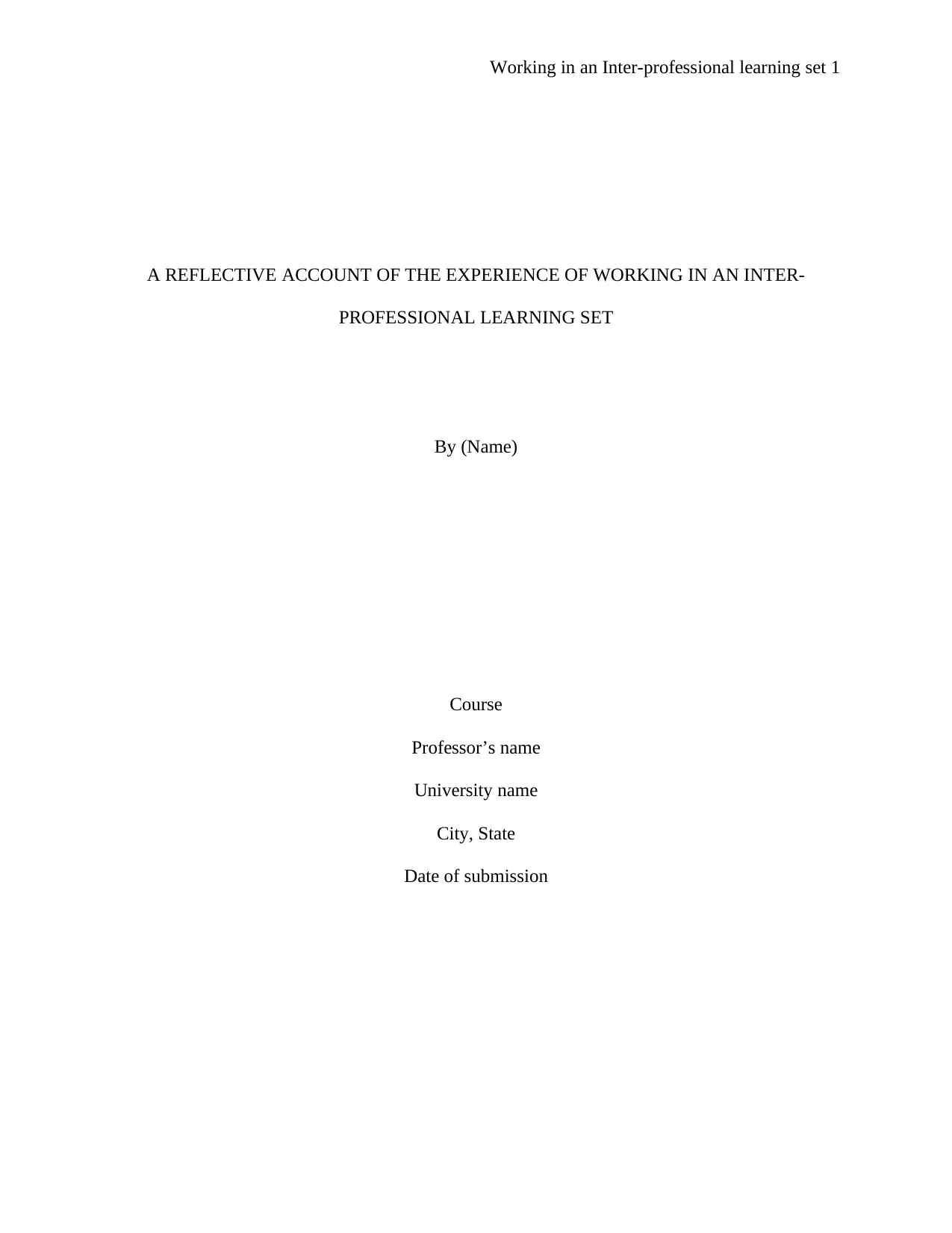
Working in an Inter-professional learning set 1
A REFLECTIVE ACCOUNT OF THE EXPERIENCE OF WORKING IN AN INTER-
PROFESSIONAL LEARNING SET
By (Name)
Course
Professor’s name
University name
City, State
Date of submission
A REFLECTIVE ACCOUNT OF THE EXPERIENCE OF WORKING IN AN INTER-
PROFESSIONAL LEARNING SET
By (Name)
Course
Professor’s name
University name
City, State
Date of submission
Secure Best Marks with AI Grader
Need help grading? Try our AI Grader for instant feedback on your assignments.
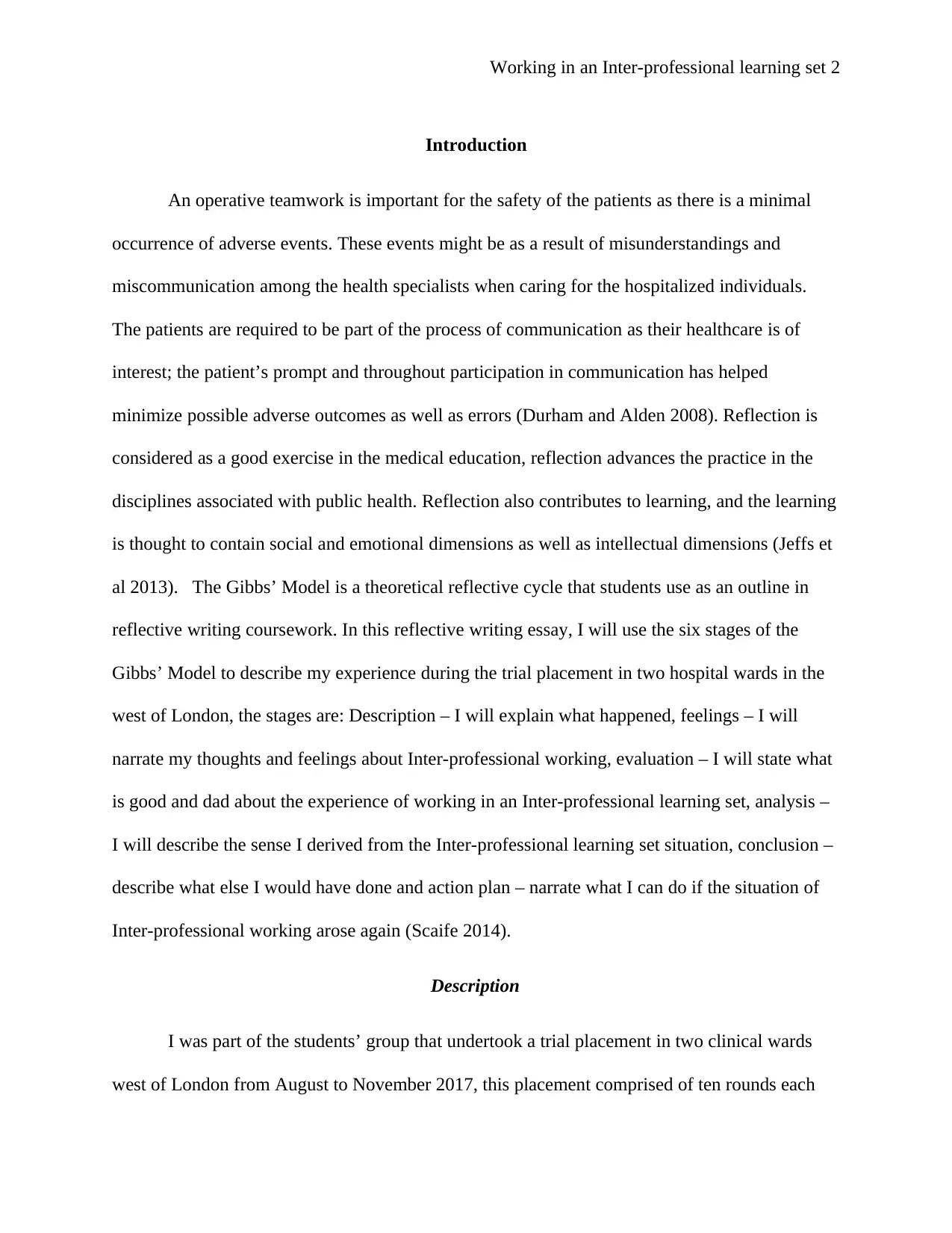
Working in an Inter-professional learning set 2
Introduction
An operative teamwork is important for the safety of the patients as there is a minimal
occurrence of adverse events. These events might be as a result of misunderstandings and
miscommunication among the health specialists when caring for the hospitalized individuals.
The patients are required to be part of the process of communication as their healthcare is of
interest; the patient’s prompt and throughout participation in communication has helped
minimize possible adverse outcomes as well as errors (Durham and Alden 2008). Reflection is
considered as a good exercise in the medical education, reflection advances the practice in the
disciplines associated with public health. Reflection also contributes to learning, and the learning
is thought to contain social and emotional dimensions as well as intellectual dimensions (Jeffs et
al 2013). The Gibbs’ Model is a theoretical reflective cycle that students use as an outline in
reflective writing coursework. In this reflective writing essay, I will use the six stages of the
Gibbs’ Model to describe my experience during the trial placement in two hospital wards in the
west of London, the stages are: Description – I will explain what happened, feelings – I will
narrate my thoughts and feelings about Inter-professional working, evaluation – I will state what
is good and dad about the experience of working in an Inter-professional learning set, analysis –
I will describe the sense I derived from the Inter-professional learning set situation, conclusion –
describe what else I would have done and action plan – narrate what I can do if the situation of
Inter-professional working arose again (Scaife 2014).
Description
I was part of the students’ group that undertook a trial placement in two clinical wards
west of London from August to November 2017, this placement comprised of ten rounds each
Introduction
An operative teamwork is important for the safety of the patients as there is a minimal
occurrence of adverse events. These events might be as a result of misunderstandings and
miscommunication among the health specialists when caring for the hospitalized individuals.
The patients are required to be part of the process of communication as their healthcare is of
interest; the patient’s prompt and throughout participation in communication has helped
minimize possible adverse outcomes as well as errors (Durham and Alden 2008). Reflection is
considered as a good exercise in the medical education, reflection advances the practice in the
disciplines associated with public health. Reflection also contributes to learning, and the learning
is thought to contain social and emotional dimensions as well as intellectual dimensions (Jeffs et
al 2013). The Gibbs’ Model is a theoretical reflective cycle that students use as an outline in
reflective writing coursework. In this reflective writing essay, I will use the six stages of the
Gibbs’ Model to describe my experience during the trial placement in two hospital wards in the
west of London, the stages are: Description – I will explain what happened, feelings – I will
narrate my thoughts and feelings about Inter-professional working, evaluation – I will state what
is good and dad about the experience of working in an Inter-professional learning set, analysis –
I will describe the sense I derived from the Inter-professional learning set situation, conclusion –
describe what else I would have done and action plan – narrate what I can do if the situation of
Inter-professional working arose again (Scaife 2014).
Description
I was part of the students’ group that undertook a trial placement in two clinical wards
west of London from August to November 2017, this placement comprised of ten rounds each
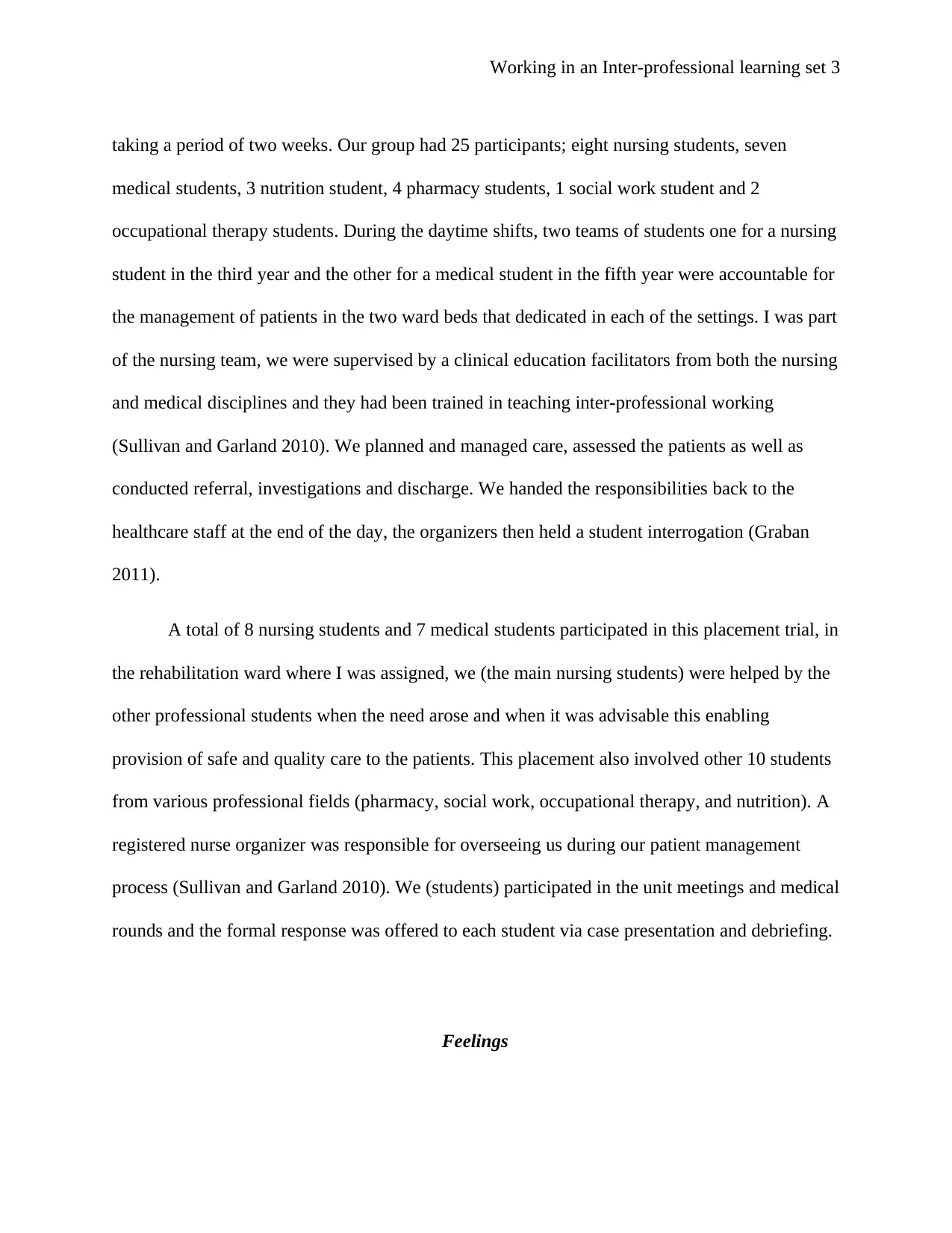
Working in an Inter-professional learning set 3
taking a period of two weeks. Our group had 25 participants; eight nursing students, seven
medical students, 3 nutrition student, 4 pharmacy students, 1 social work student and 2
occupational therapy students. During the daytime shifts, two teams of students one for a nursing
student in the third year and the other for a medical student in the fifth year were accountable for
the management of patients in the two ward beds that dedicated in each of the settings. I was part
of the nursing team, we were supervised by a clinical education facilitators from both the nursing
and medical disciplines and they had been trained in teaching inter-professional working
(Sullivan and Garland 2010). We planned and managed care, assessed the patients as well as
conducted referral, investigations and discharge. We handed the responsibilities back to the
healthcare staff at the end of the day, the organizers then held a student interrogation (Graban
2011).
A total of 8 nursing students and 7 medical students participated in this placement trial, in
the rehabilitation ward where I was assigned, we (the main nursing students) were helped by the
other professional students when the need arose and when it was advisable this enabling
provision of safe and quality care to the patients. This placement also involved other 10 students
from various professional fields (pharmacy, social work, occupational therapy, and nutrition). A
registered nurse organizer was responsible for overseeing us during our patient management
process (Sullivan and Garland 2010). We (students) participated in the unit meetings and medical
rounds and the formal response was offered to each student via case presentation and debriefing.
Feelings
taking a period of two weeks. Our group had 25 participants; eight nursing students, seven
medical students, 3 nutrition student, 4 pharmacy students, 1 social work student and 2
occupational therapy students. During the daytime shifts, two teams of students one for a nursing
student in the third year and the other for a medical student in the fifth year were accountable for
the management of patients in the two ward beds that dedicated in each of the settings. I was part
of the nursing team, we were supervised by a clinical education facilitators from both the nursing
and medical disciplines and they had been trained in teaching inter-professional working
(Sullivan and Garland 2010). We planned and managed care, assessed the patients as well as
conducted referral, investigations and discharge. We handed the responsibilities back to the
healthcare staff at the end of the day, the organizers then held a student interrogation (Graban
2011).
A total of 8 nursing students and 7 medical students participated in this placement trial, in
the rehabilitation ward where I was assigned, we (the main nursing students) were helped by the
other professional students when the need arose and when it was advisable this enabling
provision of safe and quality care to the patients. This placement also involved other 10 students
from various professional fields (pharmacy, social work, occupational therapy, and nutrition). A
registered nurse organizer was responsible for overseeing us during our patient management
process (Sullivan and Garland 2010). We (students) participated in the unit meetings and medical
rounds and the formal response was offered to each student via case presentation and debriefing.
Feelings
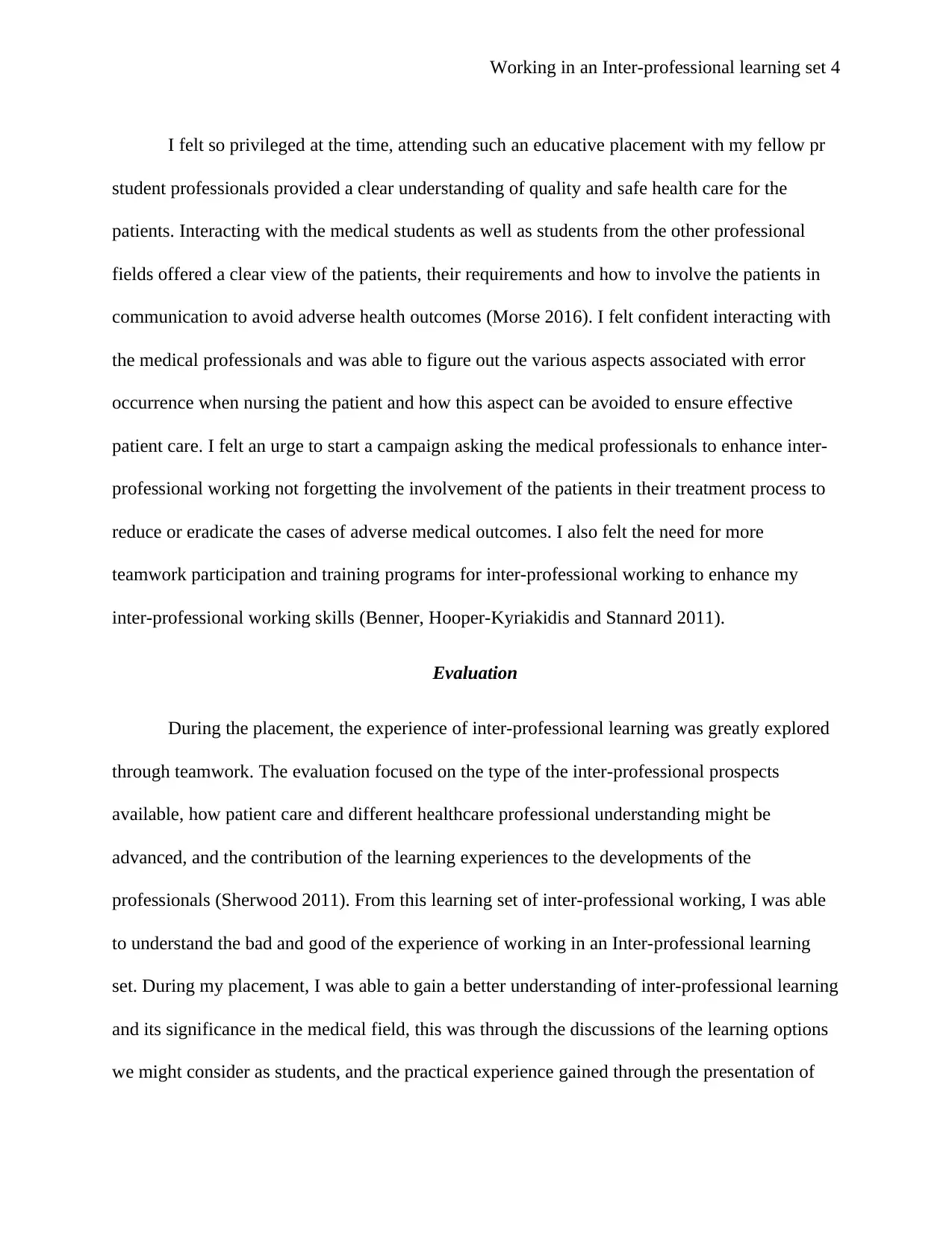
Working in an Inter-professional learning set 4
I felt so privileged at the time, attending such an educative placement with my fellow pr
student professionals provided a clear understanding of quality and safe health care for the
patients. Interacting with the medical students as well as students from the other professional
fields offered a clear view of the patients, their requirements and how to involve the patients in
communication to avoid adverse health outcomes (Morse 2016). I felt confident interacting with
the medical professionals and was able to figure out the various aspects associated with error
occurrence when nursing the patient and how this aspect can be avoided to ensure effective
patient care. I felt an urge to start a campaign asking the medical professionals to enhance inter-
professional working not forgetting the involvement of the patients in their treatment process to
reduce or eradicate the cases of adverse medical outcomes. I also felt the need for more
teamwork participation and training programs for inter-professional working to enhance my
inter-professional working skills (Benner, Hooper-Kyriakidis and Stannard 2011).
Evaluation
During the placement, the experience of inter-professional learning was greatly explored
through teamwork. The evaluation focused on the type of the inter-professional prospects
available, how patient care and different healthcare professional understanding might be
advanced, and the contribution of the learning experiences to the developments of the
professionals (Sherwood 2011). From this learning set of inter-professional working, I was able
to understand the bad and good of the experience of working in an Inter-professional learning
set. During my placement, I was able to gain a better understanding of inter-professional learning
and its significance in the medical field, this was through the discussions of the learning options
we might consider as students, and the practical experience gained through the presentation of
I felt so privileged at the time, attending such an educative placement with my fellow pr
student professionals provided a clear understanding of quality and safe health care for the
patients. Interacting with the medical students as well as students from the other professional
fields offered a clear view of the patients, their requirements and how to involve the patients in
communication to avoid adverse health outcomes (Morse 2016). I felt confident interacting with
the medical professionals and was able to figure out the various aspects associated with error
occurrence when nursing the patient and how this aspect can be avoided to ensure effective
patient care. I felt an urge to start a campaign asking the medical professionals to enhance inter-
professional working not forgetting the involvement of the patients in their treatment process to
reduce or eradicate the cases of adverse medical outcomes. I also felt the need for more
teamwork participation and training programs for inter-professional working to enhance my
inter-professional working skills (Benner, Hooper-Kyriakidis and Stannard 2011).
Evaluation
During the placement, the experience of inter-professional learning was greatly explored
through teamwork. The evaluation focused on the type of the inter-professional prospects
available, how patient care and different healthcare professional understanding might be
advanced, and the contribution of the learning experiences to the developments of the
professionals (Sherwood 2011). From this learning set of inter-professional working, I was able
to understand the bad and good of the experience of working in an Inter-professional learning
set. During my placement, I was able to gain a better understanding of inter-professional learning
and its significance in the medical field, this was through the discussions of the learning options
we might consider as students, and the practical experience gained through the presentation of
Secure Best Marks with AI Grader
Need help grading? Try our AI Grader for instant feedback on your assignments.
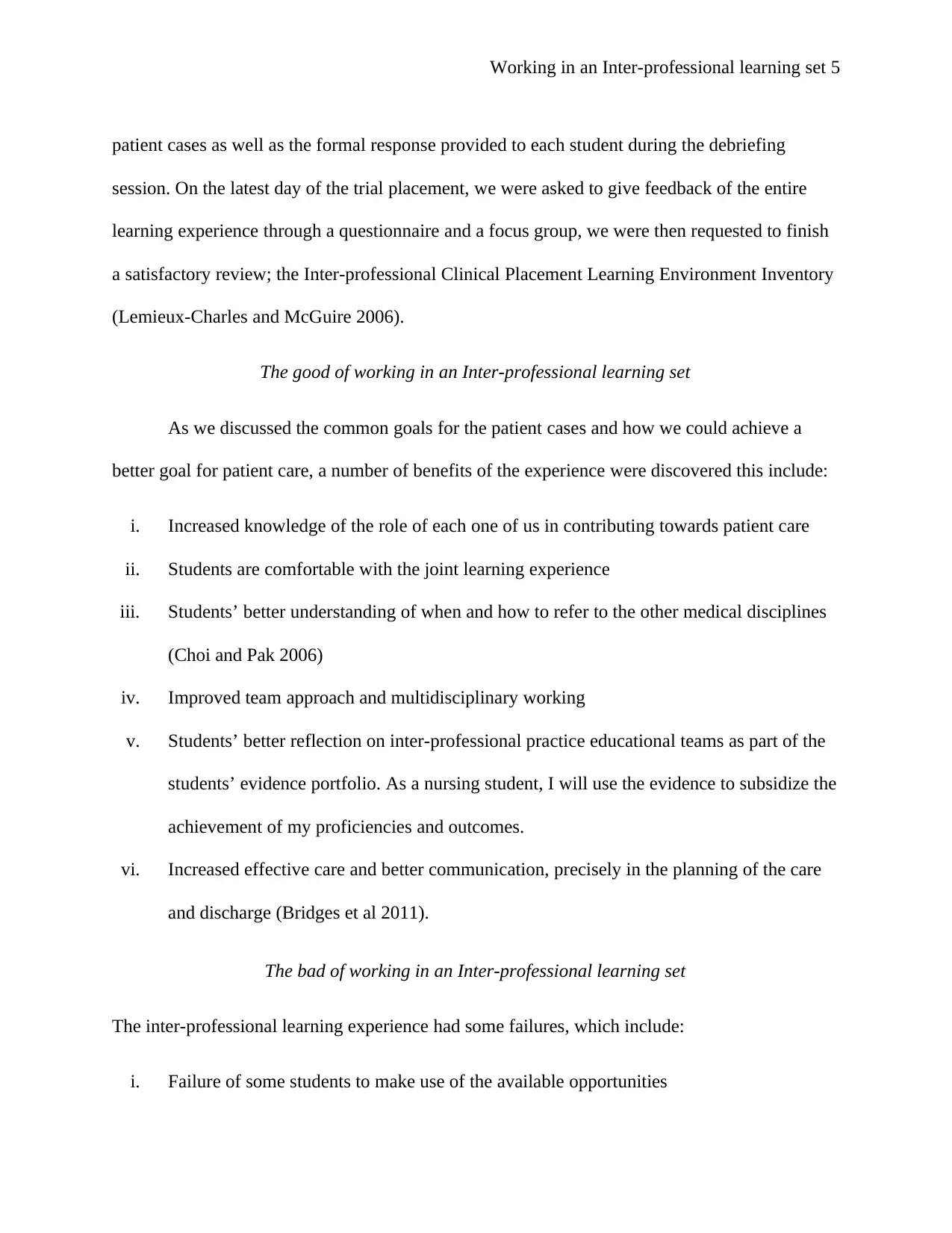
Working in an Inter-professional learning set 5
patient cases as well as the formal response provided to each student during the debriefing
session. On the latest day of the trial placement, we were asked to give feedback of the entire
learning experience through a questionnaire and a focus group, we were then requested to finish
a satisfactory review; the Inter-professional Clinical Placement Learning Environment Inventory
(Lemieux-Charles and McGuire 2006).
The good of working in an Inter-professional learning set
As we discussed the common goals for the patient cases and how we could achieve a
better goal for patient care, a number of benefits of the experience were discovered this include:
i. Increased knowledge of the role of each one of us in contributing towards patient care
ii. Students are comfortable with the joint learning experience
iii. Students’ better understanding of when and how to refer to the other medical disciplines
(Choi and Pak 2006)
iv. Improved team approach and multidisciplinary working
v. Students’ better reflection on inter-professional practice educational teams as part of the
students’ evidence portfolio. As a nursing student, I will use the evidence to subsidize the
achievement of my proficiencies and outcomes.
vi. Increased effective care and better communication, precisely in the planning of the care
and discharge (Bridges et al 2011).
The bad of working in an Inter-professional learning set
The inter-professional learning experience had some failures, which include:
i. Failure of some students to make use of the available opportunities
patient cases as well as the formal response provided to each student during the debriefing
session. On the latest day of the trial placement, we were asked to give feedback of the entire
learning experience through a questionnaire and a focus group, we were then requested to finish
a satisfactory review; the Inter-professional Clinical Placement Learning Environment Inventory
(Lemieux-Charles and McGuire 2006).
The good of working in an Inter-professional learning set
As we discussed the common goals for the patient cases and how we could achieve a
better goal for patient care, a number of benefits of the experience were discovered this include:
i. Increased knowledge of the role of each one of us in contributing towards patient care
ii. Students are comfortable with the joint learning experience
iii. Students’ better understanding of when and how to refer to the other medical disciplines
(Choi and Pak 2006)
iv. Improved team approach and multidisciplinary working
v. Students’ better reflection on inter-professional practice educational teams as part of the
students’ evidence portfolio. As a nursing student, I will use the evidence to subsidize the
achievement of my proficiencies and outcomes.
vi. Increased effective care and better communication, precisely in the planning of the care
and discharge (Bridges et al 2011).
The bad of working in an Inter-professional learning set
The inter-professional learning experience had some failures, which include:
i. Failure of some students to make use of the available opportunities
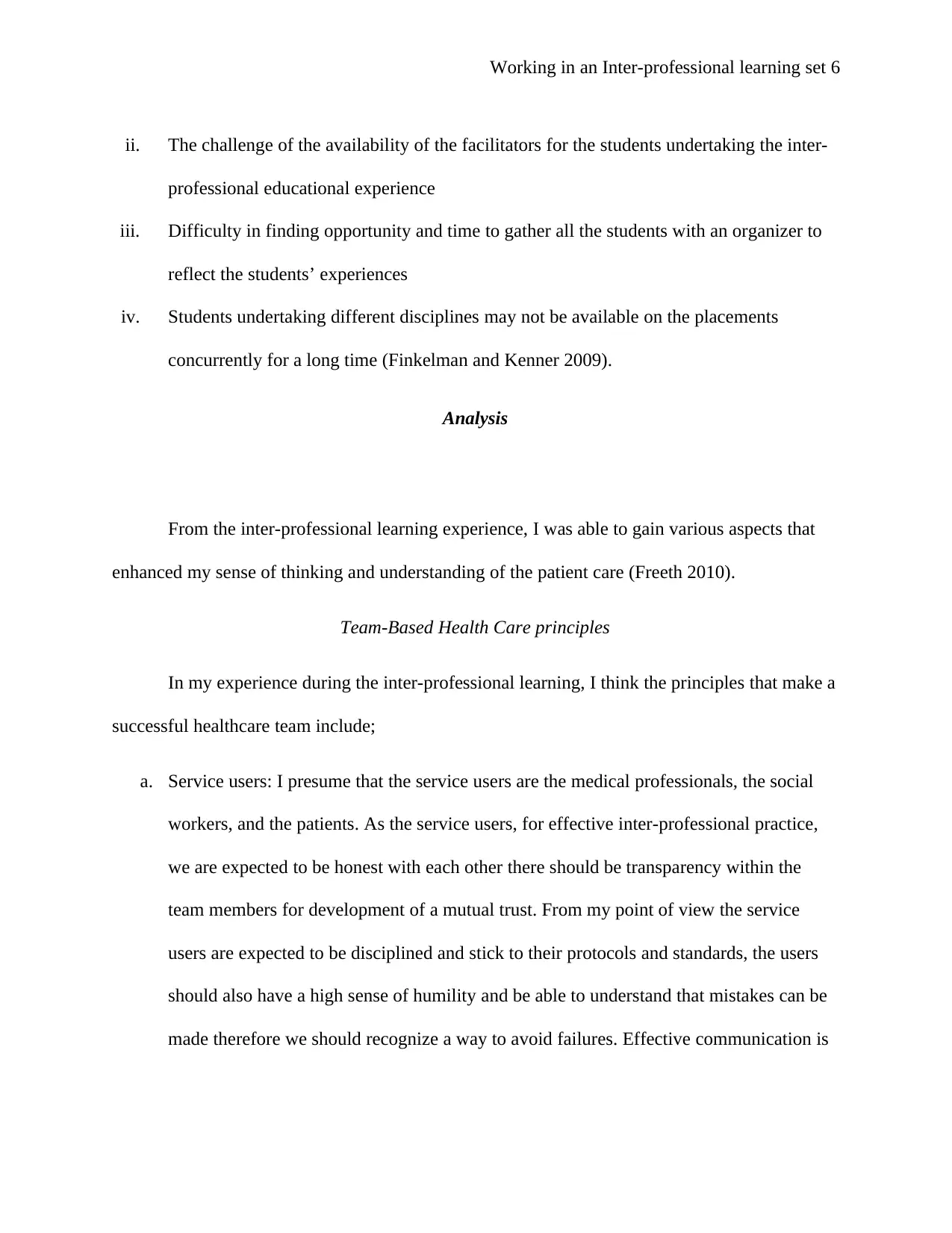
Working in an Inter-professional learning set 6
ii. The challenge of the availability of the facilitators for the students undertaking the inter-
professional educational experience
iii. Difficulty in finding opportunity and time to gather all the students with an organizer to
reflect the students’ experiences
iv. Students undertaking different disciplines may not be available on the placements
concurrently for a long time (Finkelman and Kenner 2009).
Analysis
From the inter-professional learning experience, I was able to gain various aspects that
enhanced my sense of thinking and understanding of the patient care (Freeth 2010).
Team-Based Health Care principles
In my experience during the inter-professional learning, I think the principles that make a
successful healthcare team include;
a. Service users: I presume that the service users are the medical professionals, the social
workers, and the patients. As the service users, for effective inter-professional practice,
we are expected to be honest with each other there should be transparency within the
team members for development of a mutual trust. From my point of view the service
users are expected to be disciplined and stick to their protocols and standards, the users
should also have a high sense of humility and be able to understand that mistakes can be
made therefore we should recognize a way to avoid failures. Effective communication is
ii. The challenge of the availability of the facilitators for the students undertaking the inter-
professional educational experience
iii. Difficulty in finding opportunity and time to gather all the students with an organizer to
reflect the students’ experiences
iv. Students undertaking different disciplines may not be available on the placements
concurrently for a long time (Finkelman and Kenner 2009).
Analysis
From the inter-professional learning experience, I was able to gain various aspects that
enhanced my sense of thinking and understanding of the patient care (Freeth 2010).
Team-Based Health Care principles
In my experience during the inter-professional learning, I think the principles that make a
successful healthcare team include;
a. Service users: I presume that the service users are the medical professionals, the social
workers, and the patients. As the service users, for effective inter-professional practice,
we are expected to be honest with each other there should be transparency within the
team members for development of a mutual trust. From my point of view the service
users are expected to be disciplined and stick to their protocols and standards, the users
should also have a high sense of humility and be able to understand that mistakes can be
made therefore we should recognize a way to avoid failures. Effective communication is
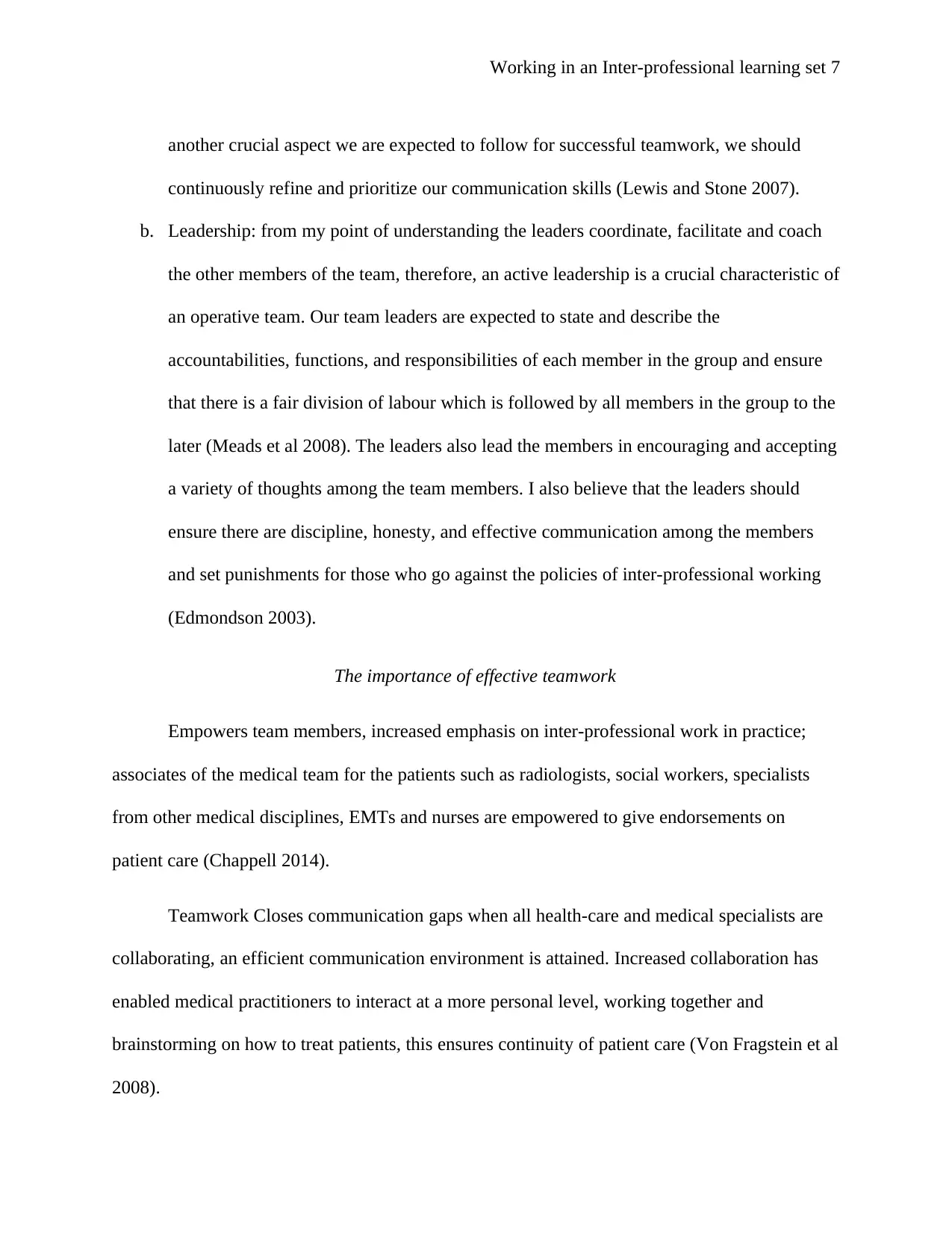
Working in an Inter-professional learning set 7
another crucial aspect we are expected to follow for successful teamwork, we should
continuously refine and prioritize our communication skills (Lewis and Stone 2007).
b. Leadership: from my point of understanding the leaders coordinate, facilitate and coach
the other members of the team, therefore, an active leadership is a crucial characteristic of
an operative team. Our team leaders are expected to state and describe the
accountabilities, functions, and responsibilities of each member in the group and ensure
that there is a fair division of labour which is followed by all members in the group to the
later (Meads et al 2008). The leaders also lead the members in encouraging and accepting
a variety of thoughts among the team members. I also believe that the leaders should
ensure there are discipline, honesty, and effective communication among the members
and set punishments for those who go against the policies of inter-professional working
(Edmondson 2003).
The importance of effective teamwork
Empowers team members, increased emphasis on inter-professional work in practice;
associates of the medical team for the patients such as radiologists, social workers, specialists
from other medical disciplines, EMTs and nurses are empowered to give endorsements on
patient care (Chappell 2014).
Teamwork Closes communication gaps when all health-care and medical specialists are
collaborating, an efficient communication environment is attained. Increased collaboration has
enabled medical practitioners to interact at a more personal level, working together and
brainstorming on how to treat patients, this ensures continuity of patient care (Von Fragstein et al
2008).
another crucial aspect we are expected to follow for successful teamwork, we should
continuously refine and prioritize our communication skills (Lewis and Stone 2007).
b. Leadership: from my point of understanding the leaders coordinate, facilitate and coach
the other members of the team, therefore, an active leadership is a crucial characteristic of
an operative team. Our team leaders are expected to state and describe the
accountabilities, functions, and responsibilities of each member in the group and ensure
that there is a fair division of labour which is followed by all members in the group to the
later (Meads et al 2008). The leaders also lead the members in encouraging and accepting
a variety of thoughts among the team members. I also believe that the leaders should
ensure there are discipline, honesty, and effective communication among the members
and set punishments for those who go against the policies of inter-professional working
(Edmondson 2003).
The importance of effective teamwork
Empowers team members, increased emphasis on inter-professional work in practice;
associates of the medical team for the patients such as radiologists, social workers, specialists
from other medical disciplines, EMTs and nurses are empowered to give endorsements on
patient care (Chappell 2014).
Teamwork Closes communication gaps when all health-care and medical specialists are
collaborating, an efficient communication environment is attained. Increased collaboration has
enabled medical practitioners to interact at a more personal level, working together and
brainstorming on how to treat patients, this ensures continuity of patient care (Von Fragstein et al
2008).
Paraphrase This Document
Need a fresh take? Get an instant paraphrase of this document with our AI Paraphraser
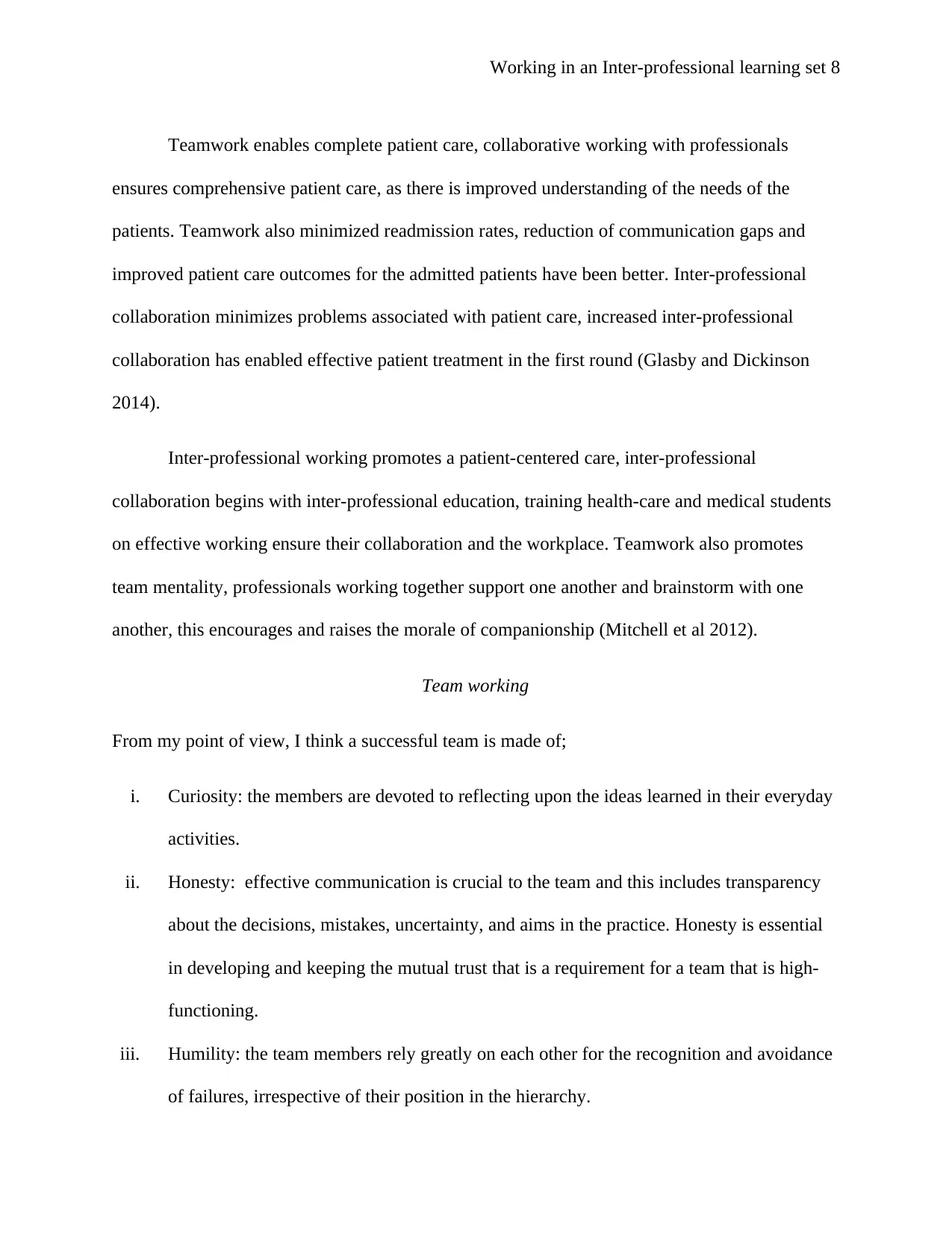
Working in an Inter-professional learning set 8
Teamwork enables complete patient care, collaborative working with professionals
ensures comprehensive patient care, as there is improved understanding of the needs of the
patients. Teamwork also minimized readmission rates, reduction of communication gaps and
improved patient care outcomes for the admitted patients have been better. Inter-professional
collaboration minimizes problems associated with patient care, increased inter-professional
collaboration has enabled effective patient treatment in the first round (Glasby and Dickinson
2014).
Inter-professional working promotes a patient-centered care, inter-professional
collaboration begins with inter-professional education, training health-care and medical students
on effective working ensure their collaboration and the workplace. Teamwork also promotes
team mentality, professionals working together support one another and brainstorm with one
another, this encourages and raises the morale of companionship (Mitchell et al 2012).
Team working
From my point of view, I think a successful team is made of;
i. Curiosity: the members are devoted to reflecting upon the ideas learned in their everyday
activities.
ii. Honesty: effective communication is crucial to the team and this includes transparency
about the decisions, mistakes, uncertainty, and aims in the practice. Honesty is essential
in developing and keeping the mutual trust that is a requirement for a team that is high-
functioning.
iii. Humility: the team members rely greatly on each other for the recognition and avoidance
of failures, irrespective of their position in the hierarchy.
Teamwork enables complete patient care, collaborative working with professionals
ensures comprehensive patient care, as there is improved understanding of the needs of the
patients. Teamwork also minimized readmission rates, reduction of communication gaps and
improved patient care outcomes for the admitted patients have been better. Inter-professional
collaboration minimizes problems associated with patient care, increased inter-professional
collaboration has enabled effective patient treatment in the first round (Glasby and Dickinson
2014).
Inter-professional working promotes a patient-centered care, inter-professional
collaboration begins with inter-professional education, training health-care and medical students
on effective working ensure their collaboration and the workplace. Teamwork also promotes
team mentality, professionals working together support one another and brainstorm with one
another, this encourages and raises the morale of companionship (Mitchell et al 2012).
Team working
From my point of view, I think a successful team is made of;
i. Curiosity: the members are devoted to reflecting upon the ideas learned in their everyday
activities.
ii. Honesty: effective communication is crucial to the team and this includes transparency
about the decisions, mistakes, uncertainty, and aims in the practice. Honesty is essential
in developing and keeping the mutual trust that is a requirement for a team that is high-
functioning.
iii. Humility: the team members rely greatly on each other for the recognition and avoidance
of failures, irrespective of their position in the hierarchy.
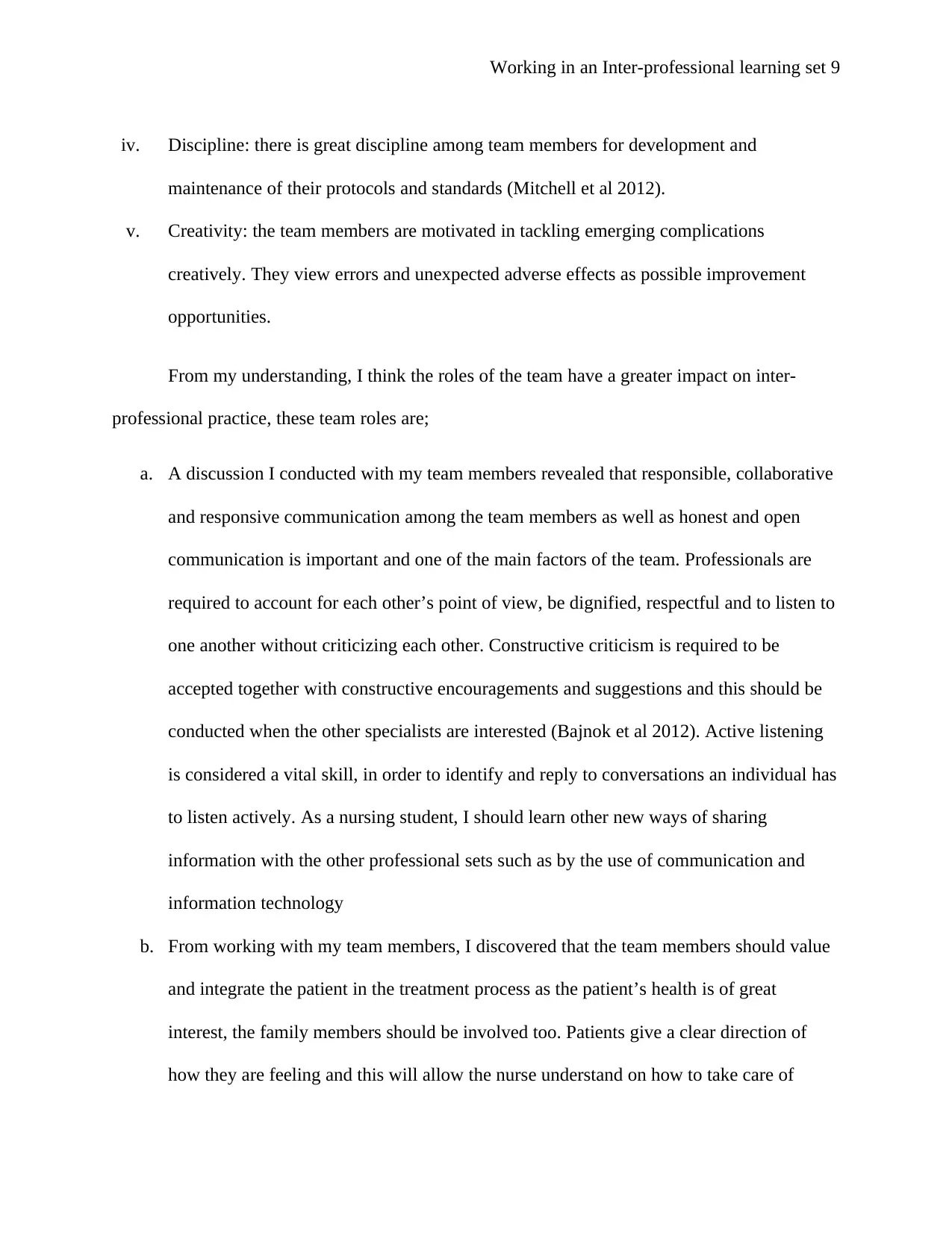
Working in an Inter-professional learning set 9
iv. Discipline: there is great discipline among team members for development and
maintenance of their protocols and standards (Mitchell et al 2012).
v. Creativity: the team members are motivated in tackling emerging complications
creatively. They view errors and unexpected adverse effects as possible improvement
opportunities.
From my understanding, I think the roles of the team have a greater impact on inter-
professional practice, these team roles are;
a. A discussion I conducted with my team members revealed that responsible, collaborative
and responsive communication among the team members as well as honest and open
communication is important and one of the main factors of the team. Professionals are
required to account for each other’s point of view, be dignified, respectful and to listen to
one another without criticizing each other. Constructive criticism is required to be
accepted together with constructive encouragements and suggestions and this should be
conducted when the other specialists are interested (Bajnok et al 2012). Active listening
is considered a vital skill, in order to identify and reply to conversations an individual has
to listen actively. As a nursing student, I should learn other new ways of sharing
information with the other professional sets such as by the use of communication and
information technology
b. From working with my team members, I discovered that the team members should value
and integrate the patient in the treatment process as the patient’s health is of great
interest, the family members should be involved too. Patients give a clear direction of
how they are feeling and this will allow the nurse understand on how to take care of
iv. Discipline: there is great discipline among team members for development and
maintenance of their protocols and standards (Mitchell et al 2012).
v. Creativity: the team members are motivated in tackling emerging complications
creatively. They view errors and unexpected adverse effects as possible improvement
opportunities.
From my understanding, I think the roles of the team have a greater impact on inter-
professional practice, these team roles are;
a. A discussion I conducted with my team members revealed that responsible, collaborative
and responsive communication among the team members as well as honest and open
communication is important and one of the main factors of the team. Professionals are
required to account for each other’s point of view, be dignified, respectful and to listen to
one another without criticizing each other. Constructive criticism is required to be
accepted together with constructive encouragements and suggestions and this should be
conducted when the other specialists are interested (Bajnok et al 2012). Active listening
is considered a vital skill, in order to identify and reply to conversations an individual has
to listen actively. As a nursing student, I should learn other new ways of sharing
information with the other professional sets such as by the use of communication and
information technology
b. From working with my team members, I discovered that the team members should value
and integrate the patient in the treatment process as the patient’s health is of great
interest, the family members should be involved too. Patients give a clear direction of
how they are feeling and this will allow the nurse understand on how to take care of
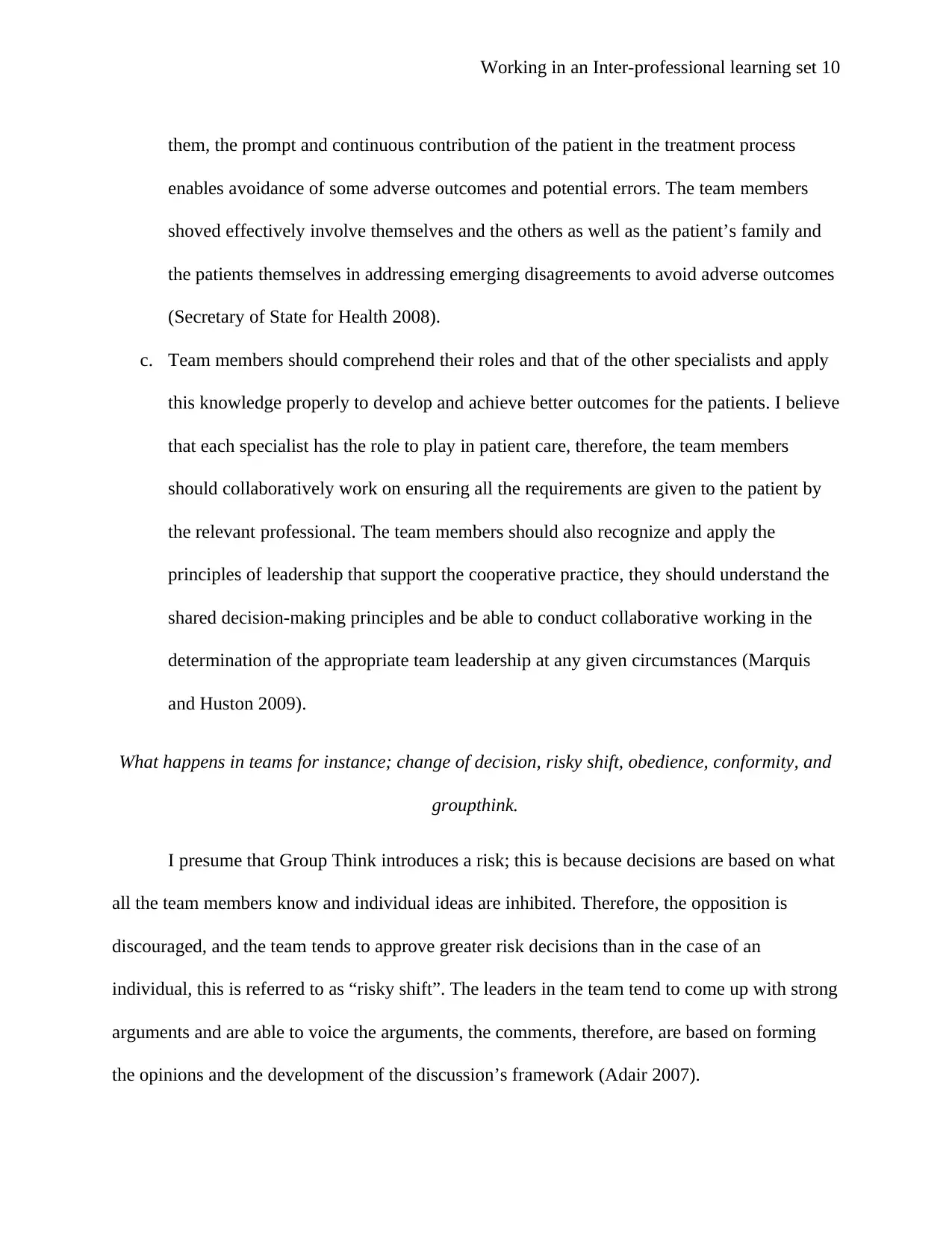
Working in an Inter-professional learning set 10
them, the prompt and continuous contribution of the patient in the treatment process
enables avoidance of some adverse outcomes and potential errors. The team members
shoved effectively involve themselves and the others as well as the patient’s family and
the patients themselves in addressing emerging disagreements to avoid adverse outcomes
(Secretary of State for Health 2008).
c. Team members should comprehend their roles and that of the other specialists and apply
this knowledge properly to develop and achieve better outcomes for the patients. I believe
that each specialist has the role to play in patient care, therefore, the team members
should collaboratively work on ensuring all the requirements are given to the patient by
the relevant professional. The team members should also recognize and apply the
principles of leadership that support the cooperative practice, they should understand the
shared decision-making principles and be able to conduct collaborative working in the
determination of the appropriate team leadership at any given circumstances (Marquis
and Huston 2009).
What happens in teams for instance; change of decision, risky shift, obedience, conformity, and
groupthink.
I presume that Group Think introduces a risk; this is because decisions are based on what
all the team members know and individual ideas are inhibited. Therefore, the opposition is
discouraged, and the team tends to approve greater risk decisions than in the case of an
individual, this is referred to as “risky shift”. The leaders in the team tend to come up with strong
arguments and are able to voice the arguments, the comments, therefore, are based on forming
the opinions and the development of the discussion’s framework (Adair 2007).
them, the prompt and continuous contribution of the patient in the treatment process
enables avoidance of some adverse outcomes and potential errors. The team members
shoved effectively involve themselves and the others as well as the patient’s family and
the patients themselves in addressing emerging disagreements to avoid adverse outcomes
(Secretary of State for Health 2008).
c. Team members should comprehend their roles and that of the other specialists and apply
this knowledge properly to develop and achieve better outcomes for the patients. I believe
that each specialist has the role to play in patient care, therefore, the team members
should collaboratively work on ensuring all the requirements are given to the patient by
the relevant professional. The team members should also recognize and apply the
principles of leadership that support the cooperative practice, they should understand the
shared decision-making principles and be able to conduct collaborative working in the
determination of the appropriate team leadership at any given circumstances (Marquis
and Huston 2009).
What happens in teams for instance; change of decision, risky shift, obedience, conformity, and
groupthink.
I presume that Group Think introduces a risk; this is because decisions are based on what
all the team members know and individual ideas are inhibited. Therefore, the opposition is
discouraged, and the team tends to approve greater risk decisions than in the case of an
individual, this is referred to as “risky shift”. The leaders in the team tend to come up with strong
arguments and are able to voice the arguments, the comments, therefore, are based on forming
the opinions and the development of the discussion’s framework (Adair 2007).
Secure Best Marks with AI Grader
Need help grading? Try our AI Grader for instant feedback on your assignments.
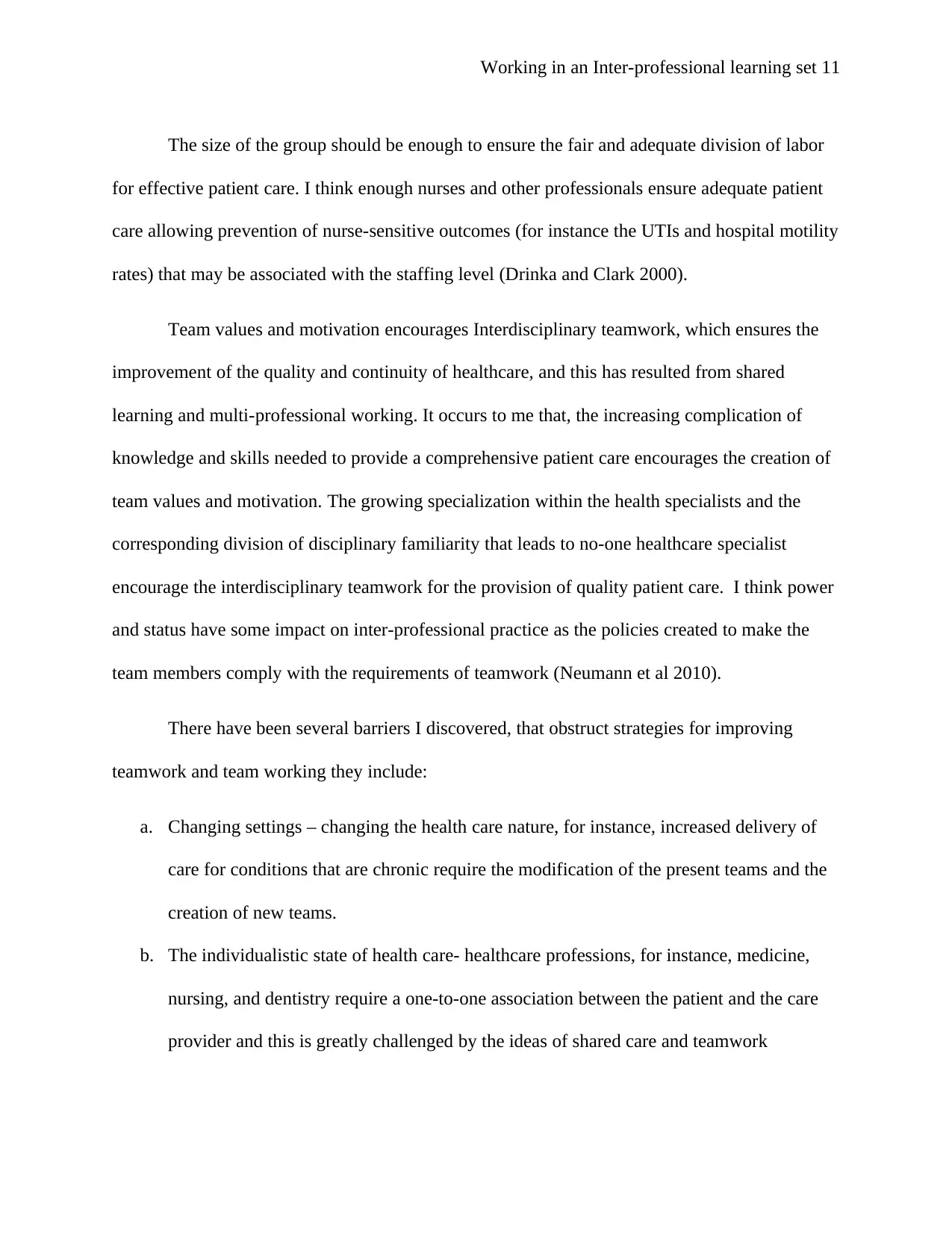
Working in an Inter-professional learning set 11
The size of the group should be enough to ensure the fair and adequate division of labor
for effective patient care. I think enough nurses and other professionals ensure adequate patient
care allowing prevention of nurse-sensitive outcomes (for instance the UTIs and hospital motility
rates) that may be associated with the staffing level (Drinka and Clark 2000).
Team values and motivation encourages Interdisciplinary teamwork, which ensures the
improvement of the quality and continuity of healthcare, and this has resulted from shared
learning and multi-professional working. It occurs to me that, the increasing complication of
knowledge and skills needed to provide a comprehensive patient care encourages the creation of
team values and motivation. The growing specialization within the health specialists and the
corresponding division of disciplinary familiarity that leads to no-one healthcare specialist
encourage the interdisciplinary teamwork for the provision of quality patient care. I think power
and status have some impact on inter-professional practice as the policies created to make the
team members comply with the requirements of teamwork (Neumann et al 2010).
There have been several barriers I discovered, that obstruct strategies for improving
teamwork and team working they include:
a. Changing settings – changing the health care nature, for instance, increased delivery of
care for conditions that are chronic require the modification of the present teams and the
creation of new teams.
b. The individualistic state of health care- healthcare professions, for instance, medicine,
nursing, and dentistry require a one-to-one association between the patient and the care
provider and this is greatly challenged by the ideas of shared care and teamwork
The size of the group should be enough to ensure the fair and adequate division of labor
for effective patient care. I think enough nurses and other professionals ensure adequate patient
care allowing prevention of nurse-sensitive outcomes (for instance the UTIs and hospital motility
rates) that may be associated with the staffing level (Drinka and Clark 2000).
Team values and motivation encourages Interdisciplinary teamwork, which ensures the
improvement of the quality and continuity of healthcare, and this has resulted from shared
learning and multi-professional working. It occurs to me that, the increasing complication of
knowledge and skills needed to provide a comprehensive patient care encourages the creation of
team values and motivation. The growing specialization within the health specialists and the
corresponding division of disciplinary familiarity that leads to no-one healthcare specialist
encourage the interdisciplinary teamwork for the provision of quality patient care. I think power
and status have some impact on inter-professional practice as the policies created to make the
team members comply with the requirements of teamwork (Neumann et al 2010).
There have been several barriers I discovered, that obstruct strategies for improving
teamwork and team working they include:
a. Changing settings – changing the health care nature, for instance, increased delivery of
care for conditions that are chronic require the modification of the present teams and the
creation of new teams.
b. The individualistic state of health care- healthcare professions, for instance, medicine,
nursing, and dentistry require a one-to-one association between the patient and the care
provider and this is greatly challenged by the ideas of shared care and teamwork
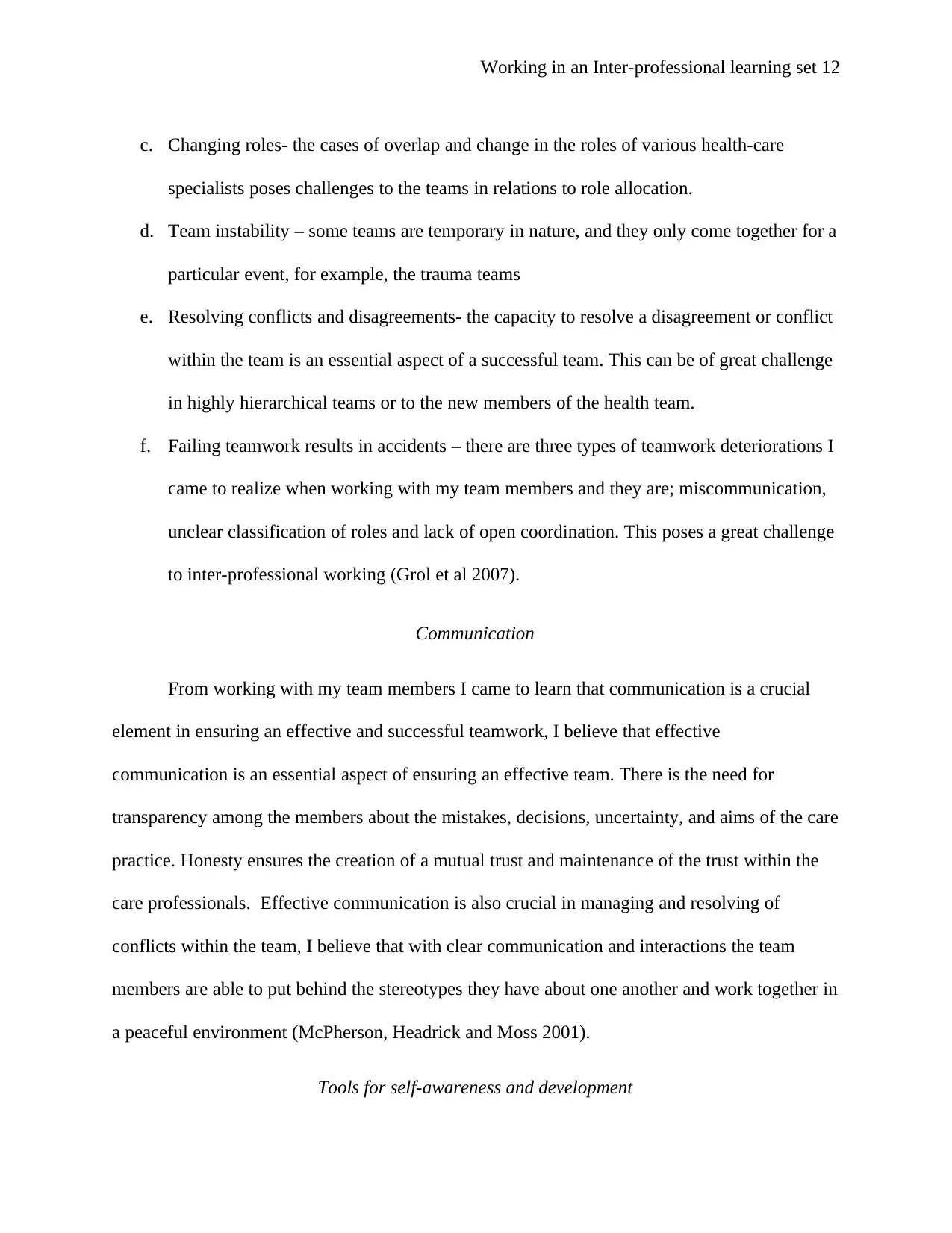
Working in an Inter-professional learning set 12
c. Changing roles- the cases of overlap and change in the roles of various health-care
specialists poses challenges to the teams in relations to role allocation.
d. Team instability – some teams are temporary in nature, and they only come together for a
particular event, for example, the trauma teams
e. Resolving conflicts and disagreements- the capacity to resolve a disagreement or conflict
within the team is an essential aspect of a successful team. This can be of great challenge
in highly hierarchical teams or to the new members of the health team.
f. Failing teamwork results in accidents – there are three types of teamwork deteriorations I
came to realize when working with my team members and they are; miscommunication,
unclear classification of roles and lack of open coordination. This poses a great challenge
to inter-professional working (Grol et al 2007).
Communication
From working with my team members I came to learn that communication is a crucial
element in ensuring an effective and successful teamwork, I believe that effective
communication is an essential aspect of ensuring an effective team. There is the need for
transparency among the members about the mistakes, decisions, uncertainty, and aims of the care
practice. Honesty ensures the creation of a mutual trust and maintenance of the trust within the
care professionals. Effective communication is also crucial in managing and resolving of
conflicts within the team, I believe that with clear communication and interactions the team
members are able to put behind the stereotypes they have about one another and work together in
a peaceful environment (McPherson, Headrick and Moss 2001).
Tools for self-awareness and development
c. Changing roles- the cases of overlap and change in the roles of various health-care
specialists poses challenges to the teams in relations to role allocation.
d. Team instability – some teams are temporary in nature, and they only come together for a
particular event, for example, the trauma teams
e. Resolving conflicts and disagreements- the capacity to resolve a disagreement or conflict
within the team is an essential aspect of a successful team. This can be of great challenge
in highly hierarchical teams or to the new members of the health team.
f. Failing teamwork results in accidents – there are three types of teamwork deteriorations I
came to realize when working with my team members and they are; miscommunication,
unclear classification of roles and lack of open coordination. This poses a great challenge
to inter-professional working (Grol et al 2007).
Communication
From working with my team members I came to learn that communication is a crucial
element in ensuring an effective and successful teamwork, I believe that effective
communication is an essential aspect of ensuring an effective team. There is the need for
transparency among the members about the mistakes, decisions, uncertainty, and aims of the care
practice. Honesty ensures the creation of a mutual trust and maintenance of the trust within the
care professionals. Effective communication is also crucial in managing and resolving of
conflicts within the team, I believe that with clear communication and interactions the team
members are able to put behind the stereotypes they have about one another and work together in
a peaceful environment (McPherson, Headrick and Moss 2001).
Tools for self-awareness and development
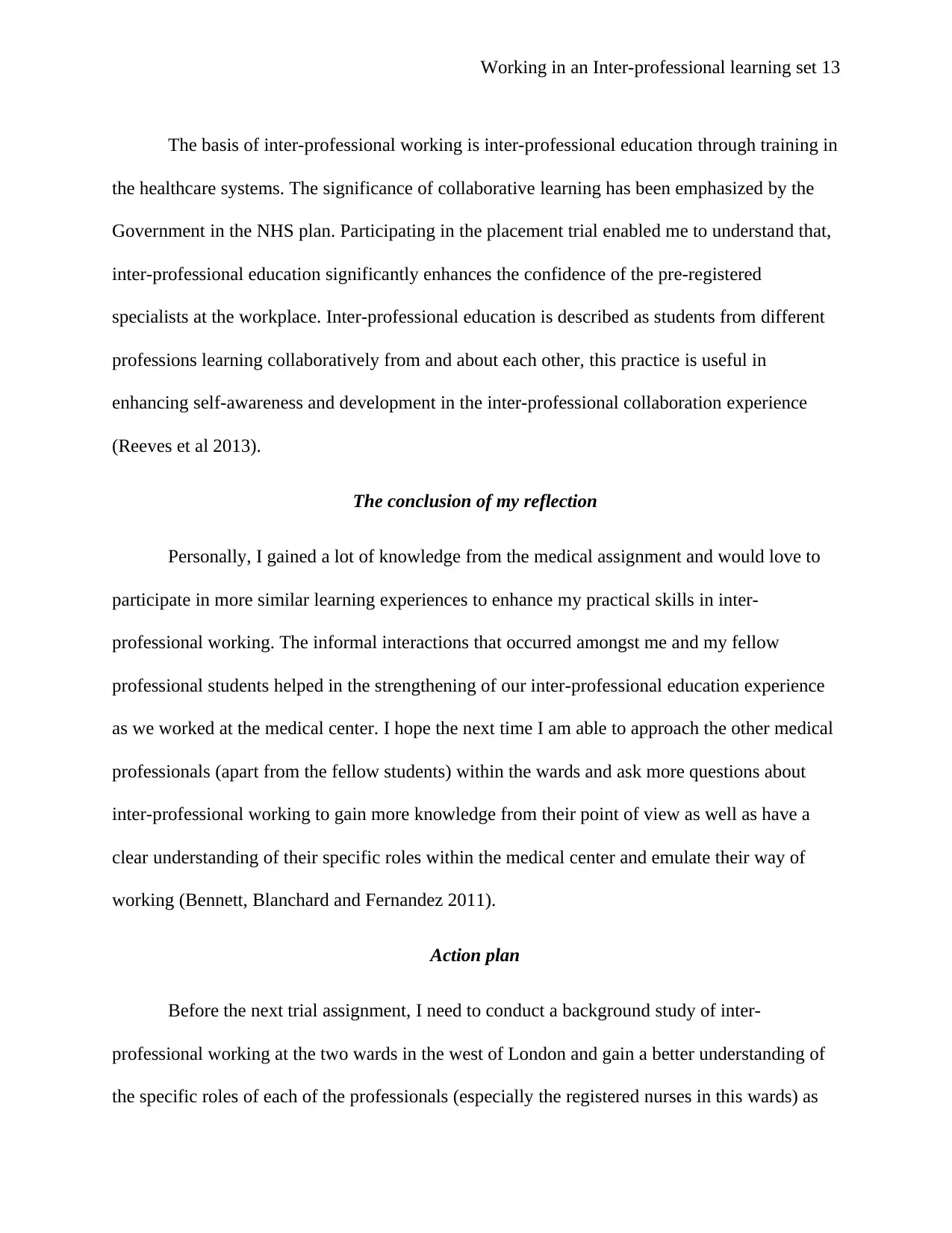
Working in an Inter-professional learning set 13
The basis of inter-professional working is inter-professional education through training in
the healthcare systems. The significance of collaborative learning has been emphasized by the
Government in the NHS plan. Participating in the placement trial enabled me to understand that,
inter-professional education significantly enhances the confidence of the pre-registered
specialists at the workplace. Inter-professional education is described as students from different
professions learning collaboratively from and about each other, this practice is useful in
enhancing self-awareness and development in the inter-professional collaboration experience
(Reeves et al 2013).
The conclusion of my reflection
Personally, I gained a lot of knowledge from the medical assignment and would love to
participate in more similar learning experiences to enhance my practical skills in inter-
professional working. The informal interactions that occurred amongst me and my fellow
professional students helped in the strengthening of our inter-professional education experience
as we worked at the medical center. I hope the next time I am able to approach the other medical
professionals (apart from the fellow students) within the wards and ask more questions about
inter-professional working to gain more knowledge from their point of view as well as have a
clear understanding of their specific roles within the medical center and emulate their way of
working (Bennett, Blanchard and Fernandez 2011).
Action plan
Before the next trial assignment, I need to conduct a background study of inter-
professional working at the two wards in the west of London and gain a better understanding of
the specific roles of each of the professionals (especially the registered nurses in this wards) as
The basis of inter-professional working is inter-professional education through training in
the healthcare systems. The significance of collaborative learning has been emphasized by the
Government in the NHS plan. Participating in the placement trial enabled me to understand that,
inter-professional education significantly enhances the confidence of the pre-registered
specialists at the workplace. Inter-professional education is described as students from different
professions learning collaboratively from and about each other, this practice is useful in
enhancing self-awareness and development in the inter-professional collaboration experience
(Reeves et al 2013).
The conclusion of my reflection
Personally, I gained a lot of knowledge from the medical assignment and would love to
participate in more similar learning experiences to enhance my practical skills in inter-
professional working. The informal interactions that occurred amongst me and my fellow
professional students helped in the strengthening of our inter-professional education experience
as we worked at the medical center. I hope the next time I am able to approach the other medical
professionals (apart from the fellow students) within the wards and ask more questions about
inter-professional working to gain more knowledge from their point of view as well as have a
clear understanding of their specific roles within the medical center and emulate their way of
working (Bennett, Blanchard and Fernandez 2011).
Action plan
Before the next trial assignment, I need to conduct a background study of inter-
professional working at the two wards in the west of London and gain a better understanding of
the specific roles of each of the professionals (especially the registered nurses in this wards) as
Paraphrase This Document
Need a fresh take? Get an instant paraphrase of this document with our AI Paraphraser
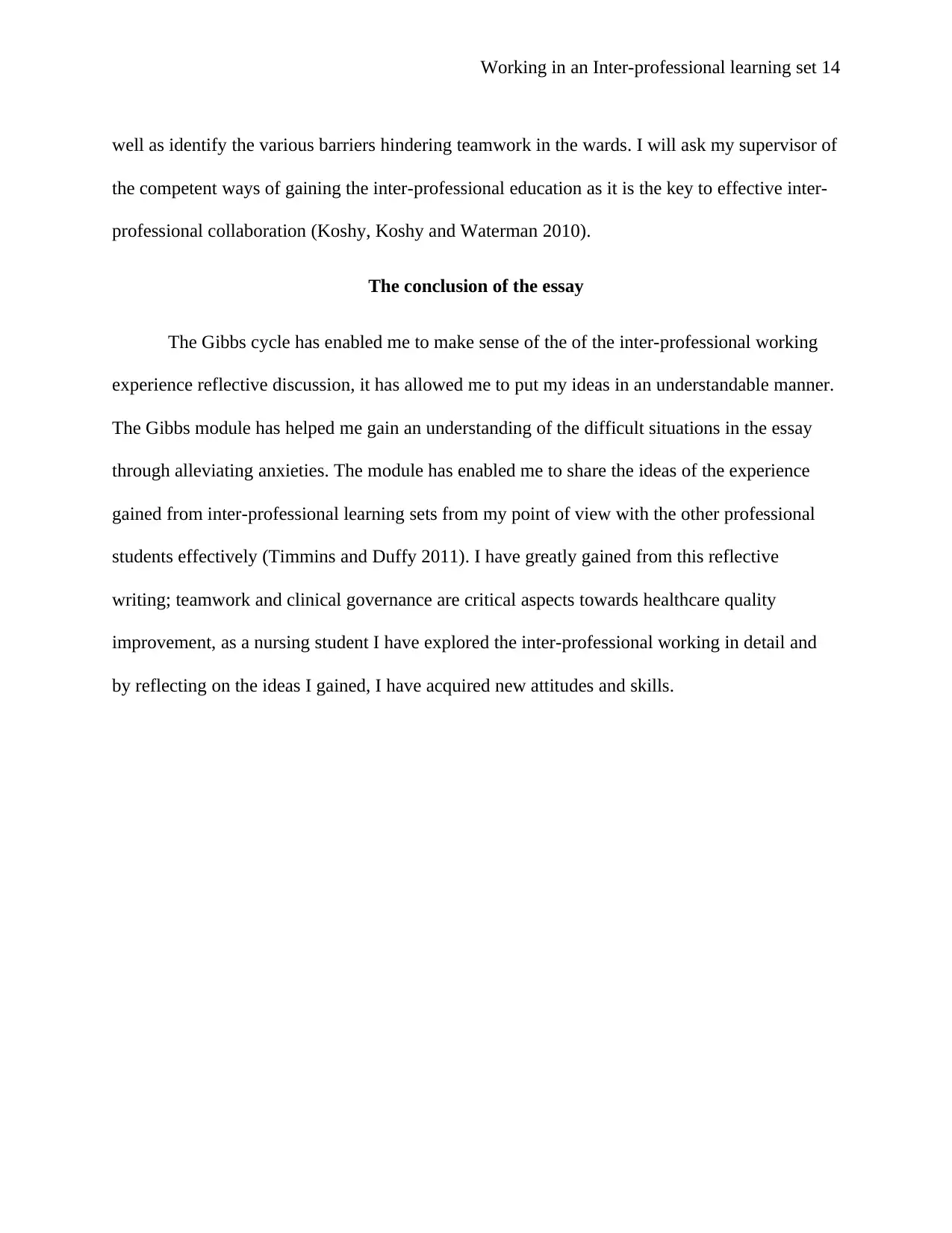
Working in an Inter-professional learning set 14
well as identify the various barriers hindering teamwork in the wards. I will ask my supervisor of
the competent ways of gaining the inter-professional education as it is the key to effective inter-
professional collaboration (Koshy, Koshy and Waterman 2010).
The conclusion of the essay
The Gibbs cycle has enabled me to make sense of the of the inter-professional working
experience reflective discussion, it has allowed me to put my ideas in an understandable manner.
The Gibbs module has helped me gain an understanding of the difficult situations in the essay
through alleviating anxieties. The module has enabled me to share the ideas of the experience
gained from inter-professional learning sets from my point of view with the other professional
students effectively (Timmins and Duffy 2011). I have greatly gained from this reflective
writing; teamwork and clinical governance are critical aspects towards healthcare quality
improvement, as a nursing student I have explored the inter-professional working in detail and
by reflecting on the ideas I gained, I have acquired new attitudes and skills.
well as identify the various barriers hindering teamwork in the wards. I will ask my supervisor of
the competent ways of gaining the inter-professional education as it is the key to effective inter-
professional collaboration (Koshy, Koshy and Waterman 2010).
The conclusion of the essay
The Gibbs cycle has enabled me to make sense of the of the inter-professional working
experience reflective discussion, it has allowed me to put my ideas in an understandable manner.
The Gibbs module has helped me gain an understanding of the difficult situations in the essay
through alleviating anxieties. The module has enabled me to share the ideas of the experience
gained from inter-professional learning sets from my point of view with the other professional
students effectively (Timmins and Duffy 2011). I have greatly gained from this reflective
writing; teamwork and clinical governance are critical aspects towards healthcare quality
improvement, as a nursing student I have explored the inter-professional working in detail and
by reflecting on the ideas I gained, I have acquired new attitudes and skills.
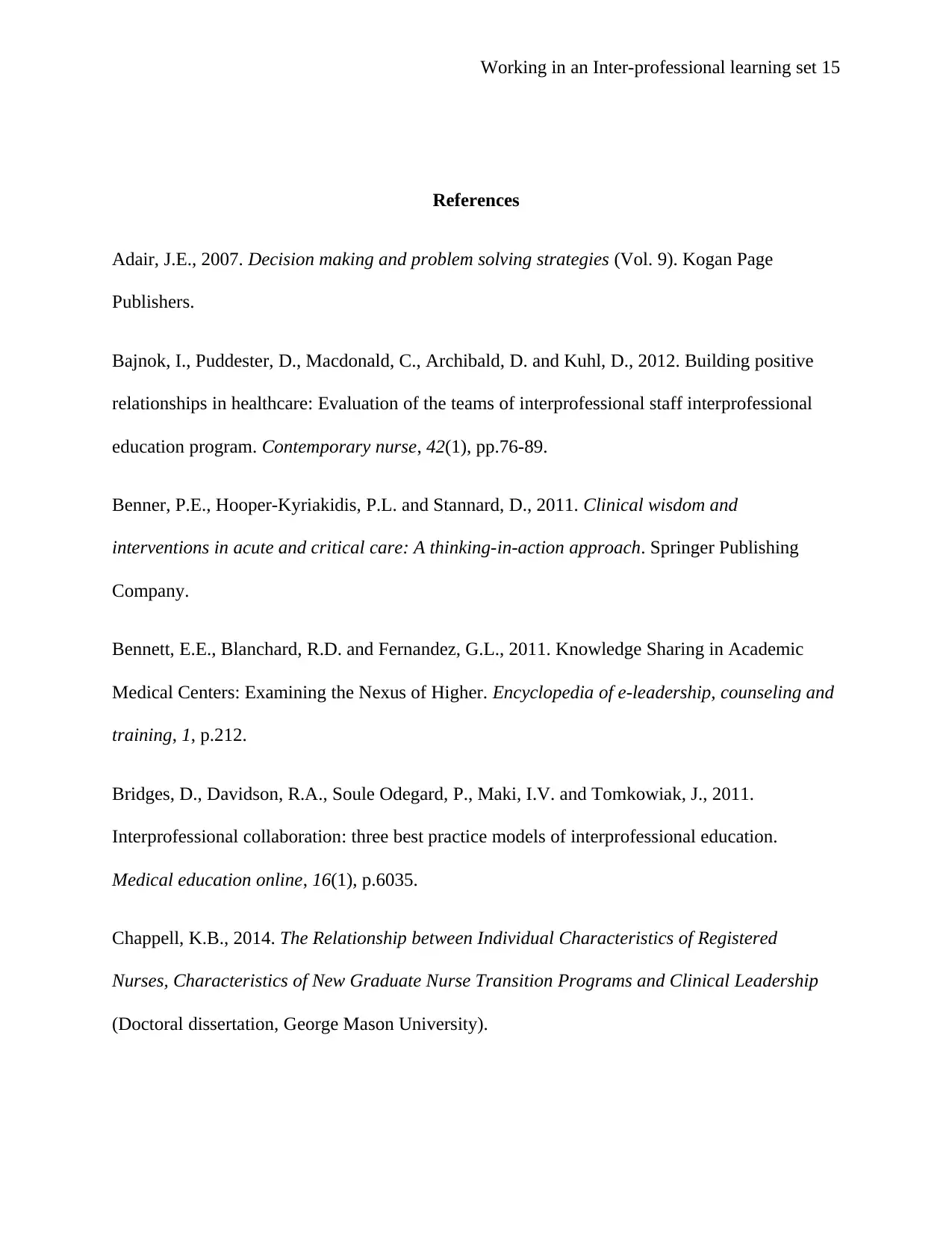
Working in an Inter-professional learning set 15
References
Adair, J.E., 2007. Decision making and problem solving strategies (Vol. 9). Kogan Page
Publishers.
Bajnok, I., Puddester, D., Macdonald, C., Archibald, D. and Kuhl, D., 2012. Building positive
relationships in healthcare: Evaluation of the teams of interprofessional staff interprofessional
education program. Contemporary nurse, 42(1), pp.76-89.
Benner, P.E., Hooper-Kyriakidis, P.L. and Stannard, D., 2011. Clinical wisdom and
interventions in acute and critical care: A thinking-in-action approach. Springer Publishing
Company.
Bennett, E.E., Blanchard, R.D. and Fernandez, G.L., 2011. Knowledge Sharing in Academic
Medical Centers: Examining the Nexus of Higher. Encyclopedia of e-leadership, counseling and
training, 1, p.212.
Bridges, D., Davidson, R.A., Soule Odegard, P., Maki, I.V. and Tomkowiak, J., 2011.
Interprofessional collaboration: three best practice models of interprofessional education.
Medical education online, 16(1), p.6035.
Chappell, K.B., 2014. The Relationship between Individual Characteristics of Registered
Nurses, Characteristics of New Graduate Nurse Transition Programs and Clinical Leadership
(Doctoral dissertation, George Mason University).
References
Adair, J.E., 2007. Decision making and problem solving strategies (Vol. 9). Kogan Page
Publishers.
Bajnok, I., Puddester, D., Macdonald, C., Archibald, D. and Kuhl, D., 2012. Building positive
relationships in healthcare: Evaluation of the teams of interprofessional staff interprofessional
education program. Contemporary nurse, 42(1), pp.76-89.
Benner, P.E., Hooper-Kyriakidis, P.L. and Stannard, D., 2011. Clinical wisdom and
interventions in acute and critical care: A thinking-in-action approach. Springer Publishing
Company.
Bennett, E.E., Blanchard, R.D. and Fernandez, G.L., 2011. Knowledge Sharing in Academic
Medical Centers: Examining the Nexus of Higher. Encyclopedia of e-leadership, counseling and
training, 1, p.212.
Bridges, D., Davidson, R.A., Soule Odegard, P., Maki, I.V. and Tomkowiak, J., 2011.
Interprofessional collaboration: three best practice models of interprofessional education.
Medical education online, 16(1), p.6035.
Chappell, K.B., 2014. The Relationship between Individual Characteristics of Registered
Nurses, Characteristics of New Graduate Nurse Transition Programs and Clinical Leadership
(Doctoral dissertation, George Mason University).
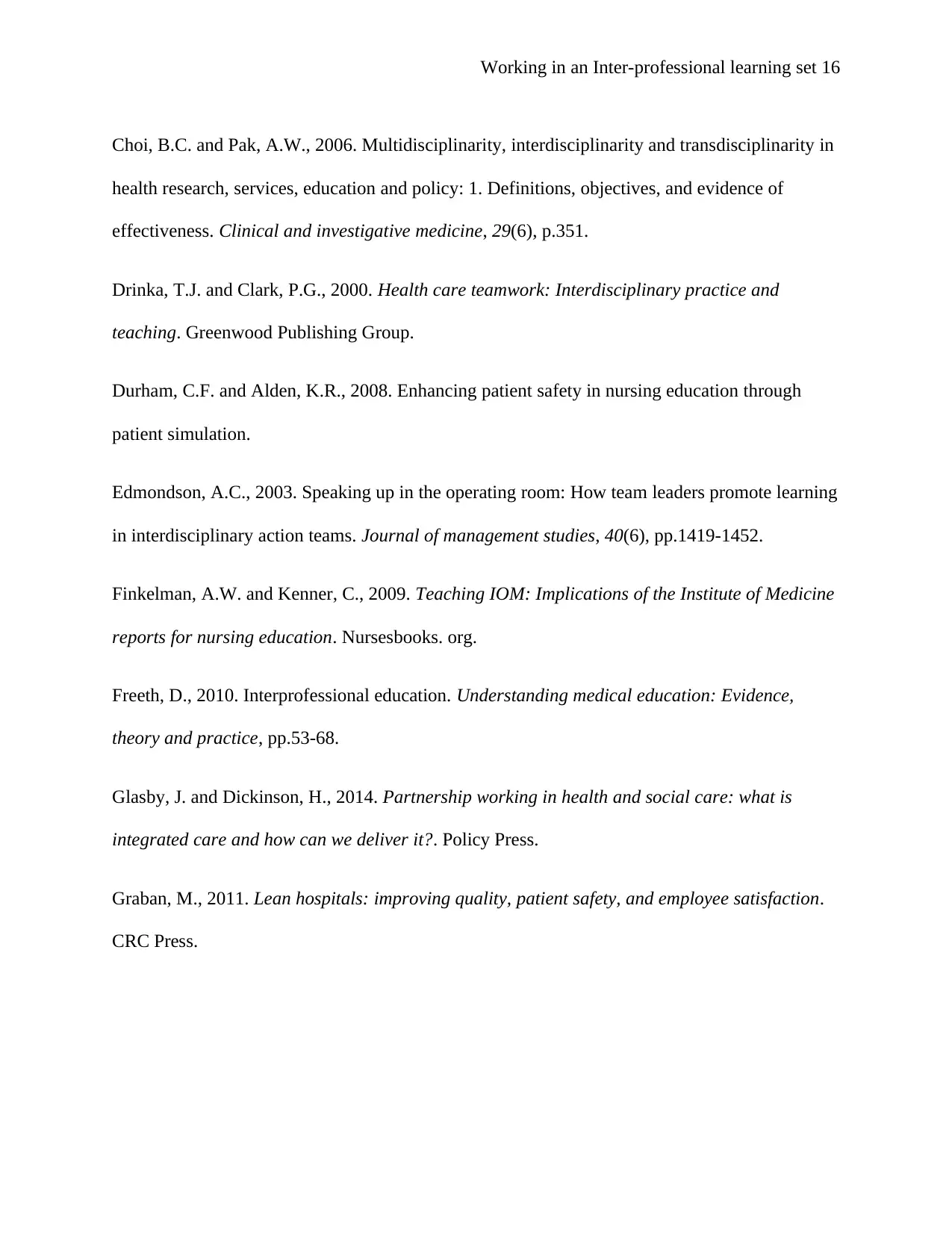
Working in an Inter-professional learning set 16
Choi, B.C. and Pak, A.W., 2006. Multidisciplinarity, interdisciplinarity and transdisciplinarity in
health research, services, education and policy: 1. Definitions, objectives, and evidence of
effectiveness. Clinical and investigative medicine, 29(6), p.351.
Drinka, T.J. and Clark, P.G., 2000. Health care teamwork: Interdisciplinary practice and
teaching. Greenwood Publishing Group.
Durham, C.F. and Alden, K.R., 2008. Enhancing patient safety in nursing education through
patient simulation.
Edmondson, A.C., 2003. Speaking up in the operating room: How team leaders promote learning
in interdisciplinary action teams. Journal of management studies, 40(6), pp.1419-1452.
Finkelman, A.W. and Kenner, C., 2009. Teaching IOM: Implications of the Institute of Medicine
reports for nursing education. Nursesbooks. org.
Freeth, D., 2010. Interprofessional education. Understanding medical education: Evidence,
theory and practice, pp.53-68.
Glasby, J. and Dickinson, H., 2014. Partnership working in health and social care: what is
integrated care and how can we deliver it?. Policy Press.
Graban, M., 2011. Lean hospitals: improving quality, patient safety, and employee satisfaction.
CRC Press.
Choi, B.C. and Pak, A.W., 2006. Multidisciplinarity, interdisciplinarity and transdisciplinarity in
health research, services, education and policy: 1. Definitions, objectives, and evidence of
effectiveness. Clinical and investigative medicine, 29(6), p.351.
Drinka, T.J. and Clark, P.G., 2000. Health care teamwork: Interdisciplinary practice and
teaching. Greenwood Publishing Group.
Durham, C.F. and Alden, K.R., 2008. Enhancing patient safety in nursing education through
patient simulation.
Edmondson, A.C., 2003. Speaking up in the operating room: How team leaders promote learning
in interdisciplinary action teams. Journal of management studies, 40(6), pp.1419-1452.
Finkelman, A.W. and Kenner, C., 2009. Teaching IOM: Implications of the Institute of Medicine
reports for nursing education. Nursesbooks. org.
Freeth, D., 2010. Interprofessional education. Understanding medical education: Evidence,
theory and practice, pp.53-68.
Glasby, J. and Dickinson, H., 2014. Partnership working in health and social care: what is
integrated care and how can we deliver it?. Policy Press.
Graban, M., 2011. Lean hospitals: improving quality, patient safety, and employee satisfaction.
CRC Press.
Secure Best Marks with AI Grader
Need help grading? Try our AI Grader for instant feedback on your assignments.
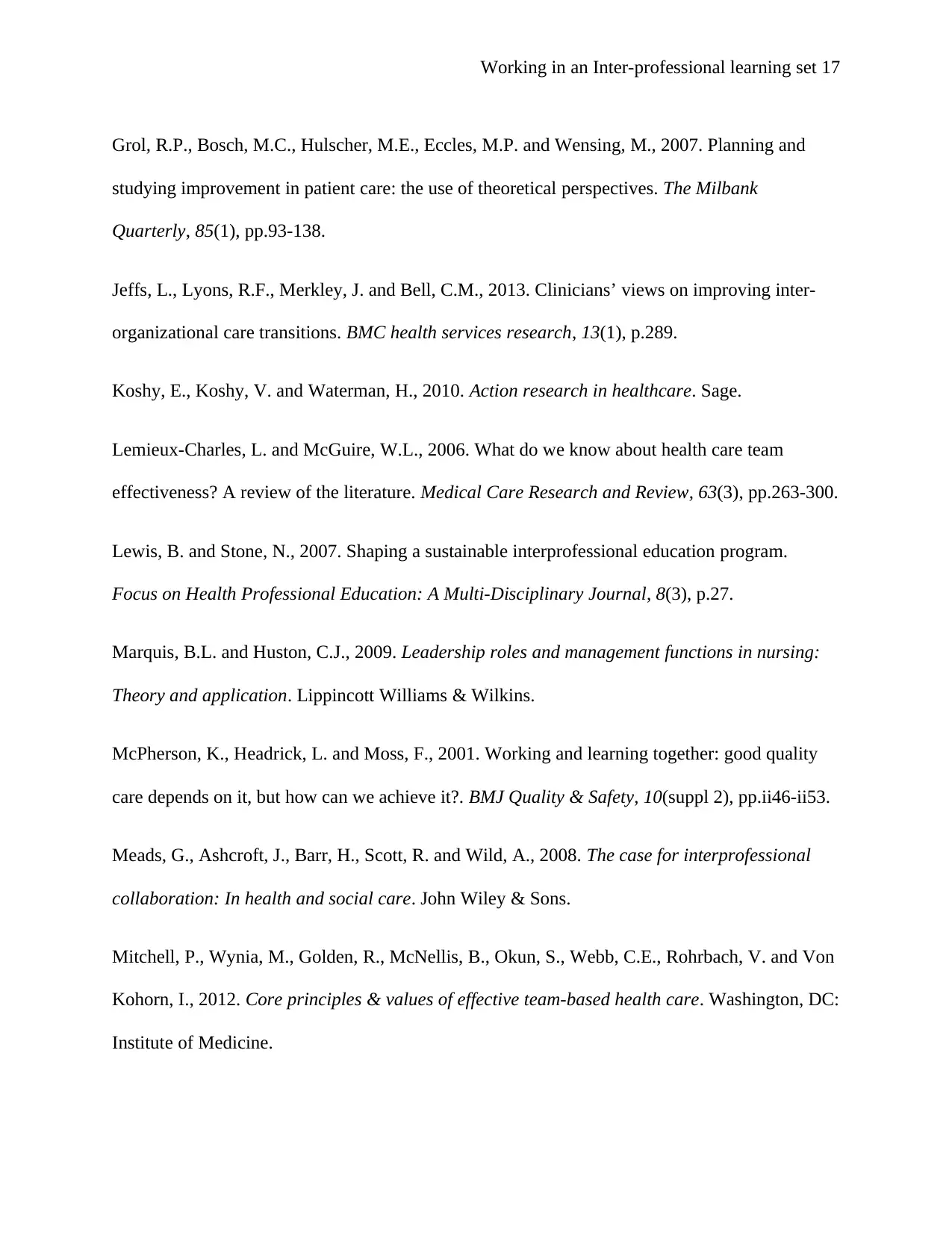
Working in an Inter-professional learning set 17
Grol, R.P., Bosch, M.C., Hulscher, M.E., Eccles, M.P. and Wensing, M., 2007. Planning and
studying improvement in patient care: the use of theoretical perspectives. The Milbank
Quarterly, 85(1), pp.93-138.
Jeffs, L., Lyons, R.F., Merkley, J. and Bell, C.M., 2013. Clinicians’ views on improving inter-
organizational care transitions. BMC health services research, 13(1), p.289.
Koshy, E., Koshy, V. and Waterman, H., 2010. Action research in healthcare. Sage.
Lemieux-Charles, L. and McGuire, W.L., 2006. What do we know about health care team
effectiveness? A review of the literature. Medical Care Research and Review, 63(3), pp.263-300.
Lewis, B. and Stone, N., 2007. Shaping a sustainable interprofessional education program.
Focus on Health Professional Education: A Multi-Disciplinary Journal, 8(3), p.27.
Marquis, B.L. and Huston, C.J., 2009. Leadership roles and management functions in nursing:
Theory and application. Lippincott Williams & Wilkins.
McPherson, K., Headrick, L. and Moss, F., 2001. Working and learning together: good quality
care depends on it, but how can we achieve it?. BMJ Quality & Safety, 10(suppl 2), pp.ii46-ii53.
Meads, G., Ashcroft, J., Barr, H., Scott, R. and Wild, A., 2008. The case for interprofessional
collaboration: In health and social care. John Wiley & Sons.
Mitchell, P., Wynia, M., Golden, R., McNellis, B., Okun, S., Webb, C.E., Rohrbach, V. and Von
Kohorn, I., 2012. Core principles & values of effective team-based health care. Washington, DC:
Institute of Medicine.
Grol, R.P., Bosch, M.C., Hulscher, M.E., Eccles, M.P. and Wensing, M., 2007. Planning and
studying improvement in patient care: the use of theoretical perspectives. The Milbank
Quarterly, 85(1), pp.93-138.
Jeffs, L., Lyons, R.F., Merkley, J. and Bell, C.M., 2013. Clinicians’ views on improving inter-
organizational care transitions. BMC health services research, 13(1), p.289.
Koshy, E., Koshy, V. and Waterman, H., 2010. Action research in healthcare. Sage.
Lemieux-Charles, L. and McGuire, W.L., 2006. What do we know about health care team
effectiveness? A review of the literature. Medical Care Research and Review, 63(3), pp.263-300.
Lewis, B. and Stone, N., 2007. Shaping a sustainable interprofessional education program.
Focus on Health Professional Education: A Multi-Disciplinary Journal, 8(3), p.27.
Marquis, B.L. and Huston, C.J., 2009. Leadership roles and management functions in nursing:
Theory and application. Lippincott Williams & Wilkins.
McPherson, K., Headrick, L. and Moss, F., 2001. Working and learning together: good quality
care depends on it, but how can we achieve it?. BMJ Quality & Safety, 10(suppl 2), pp.ii46-ii53.
Meads, G., Ashcroft, J., Barr, H., Scott, R. and Wild, A., 2008. The case for interprofessional
collaboration: In health and social care. John Wiley & Sons.
Mitchell, P., Wynia, M., Golden, R., McNellis, B., Okun, S., Webb, C.E., Rohrbach, V. and Von
Kohorn, I., 2012. Core principles & values of effective team-based health care. Washington, DC:
Institute of Medicine.
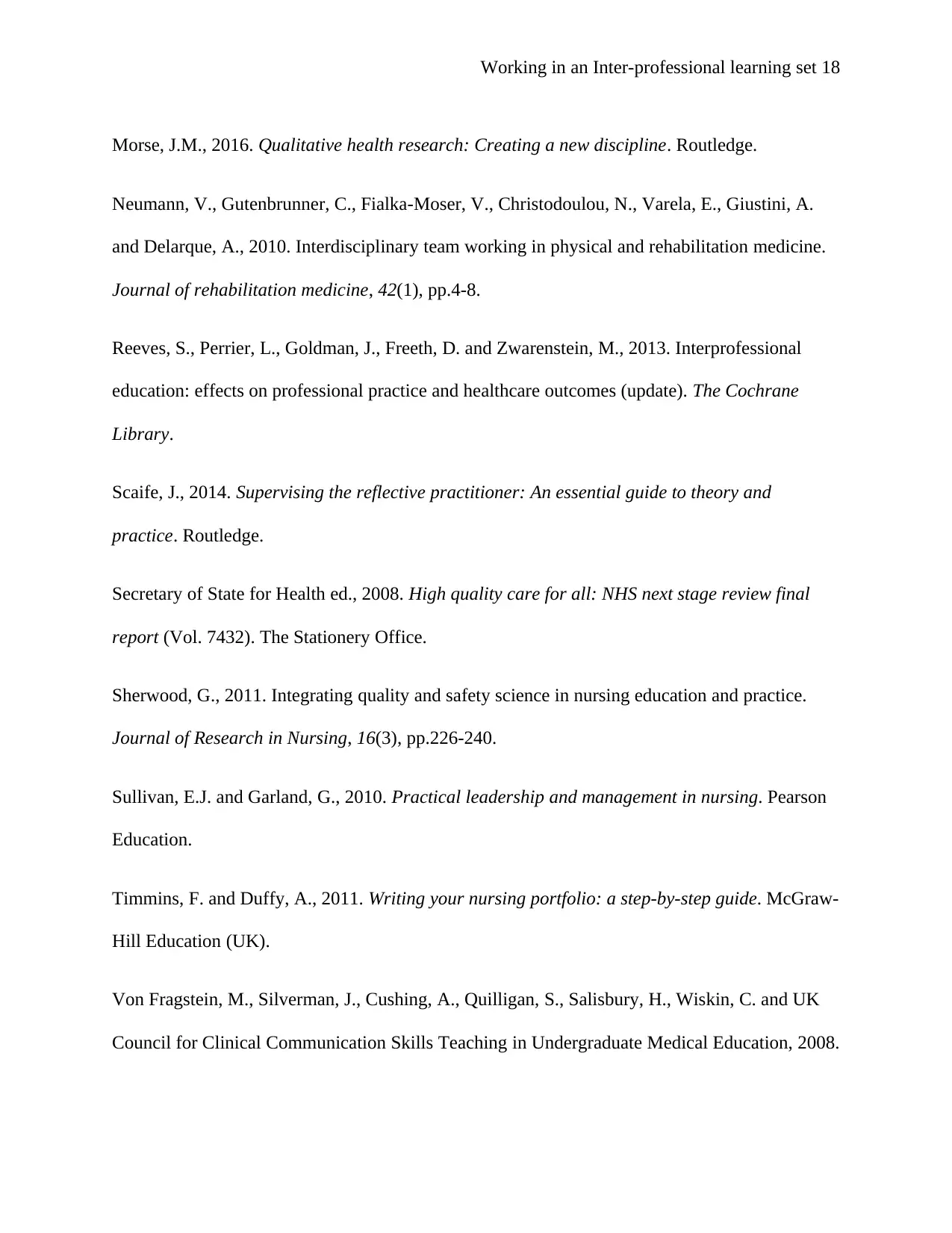
Working in an Inter-professional learning set 18
Morse, J.M., 2016. Qualitative health research: Creating a new discipline. Routledge.
Neumann, V., Gutenbrunner, C., Fialka-Moser, V., Christodoulou, N., Varela, E., Giustini, A.
and Delarque, A., 2010. Interdisciplinary team working in physical and rehabilitation medicine.
Journal of rehabilitation medicine, 42(1), pp.4-8.
Reeves, S., Perrier, L., Goldman, J., Freeth, D. and Zwarenstein, M., 2013. Interprofessional
education: effects on professional practice and healthcare outcomes (update). The Cochrane
Library.
Scaife, J., 2014. Supervising the reflective practitioner: An essential guide to theory and
practice. Routledge.
Secretary of State for Health ed., 2008. High quality care for all: NHS next stage review final
report (Vol. 7432). The Stationery Office.
Sherwood, G., 2011. Integrating quality and safety science in nursing education and practice.
Journal of Research in Nursing, 16(3), pp.226-240.
Sullivan, E.J. and Garland, G., 2010. Practical leadership and management in nursing. Pearson
Education.
Timmins, F. and Duffy, A., 2011. Writing your nursing portfolio: a step-by-step guide. McGraw-
Hill Education (UK).
Von Fragstein, M., Silverman, J., Cushing, A., Quilligan, S., Salisbury, H., Wiskin, C. and UK
Council for Clinical Communication Skills Teaching in Undergraduate Medical Education, 2008.
Morse, J.M., 2016. Qualitative health research: Creating a new discipline. Routledge.
Neumann, V., Gutenbrunner, C., Fialka-Moser, V., Christodoulou, N., Varela, E., Giustini, A.
and Delarque, A., 2010. Interdisciplinary team working in physical and rehabilitation medicine.
Journal of rehabilitation medicine, 42(1), pp.4-8.
Reeves, S., Perrier, L., Goldman, J., Freeth, D. and Zwarenstein, M., 2013. Interprofessional
education: effects on professional practice and healthcare outcomes (update). The Cochrane
Library.
Scaife, J., 2014. Supervising the reflective practitioner: An essential guide to theory and
practice. Routledge.
Secretary of State for Health ed., 2008. High quality care for all: NHS next stage review final
report (Vol. 7432). The Stationery Office.
Sherwood, G., 2011. Integrating quality and safety science in nursing education and practice.
Journal of Research in Nursing, 16(3), pp.226-240.
Sullivan, E.J. and Garland, G., 2010. Practical leadership and management in nursing. Pearson
Education.
Timmins, F. and Duffy, A., 2011. Writing your nursing portfolio: a step-by-step guide. McGraw-
Hill Education (UK).
Von Fragstein, M., Silverman, J., Cushing, A., Quilligan, S., Salisbury, H., Wiskin, C. and UK
Council for Clinical Communication Skills Teaching in Undergraduate Medical Education, 2008.
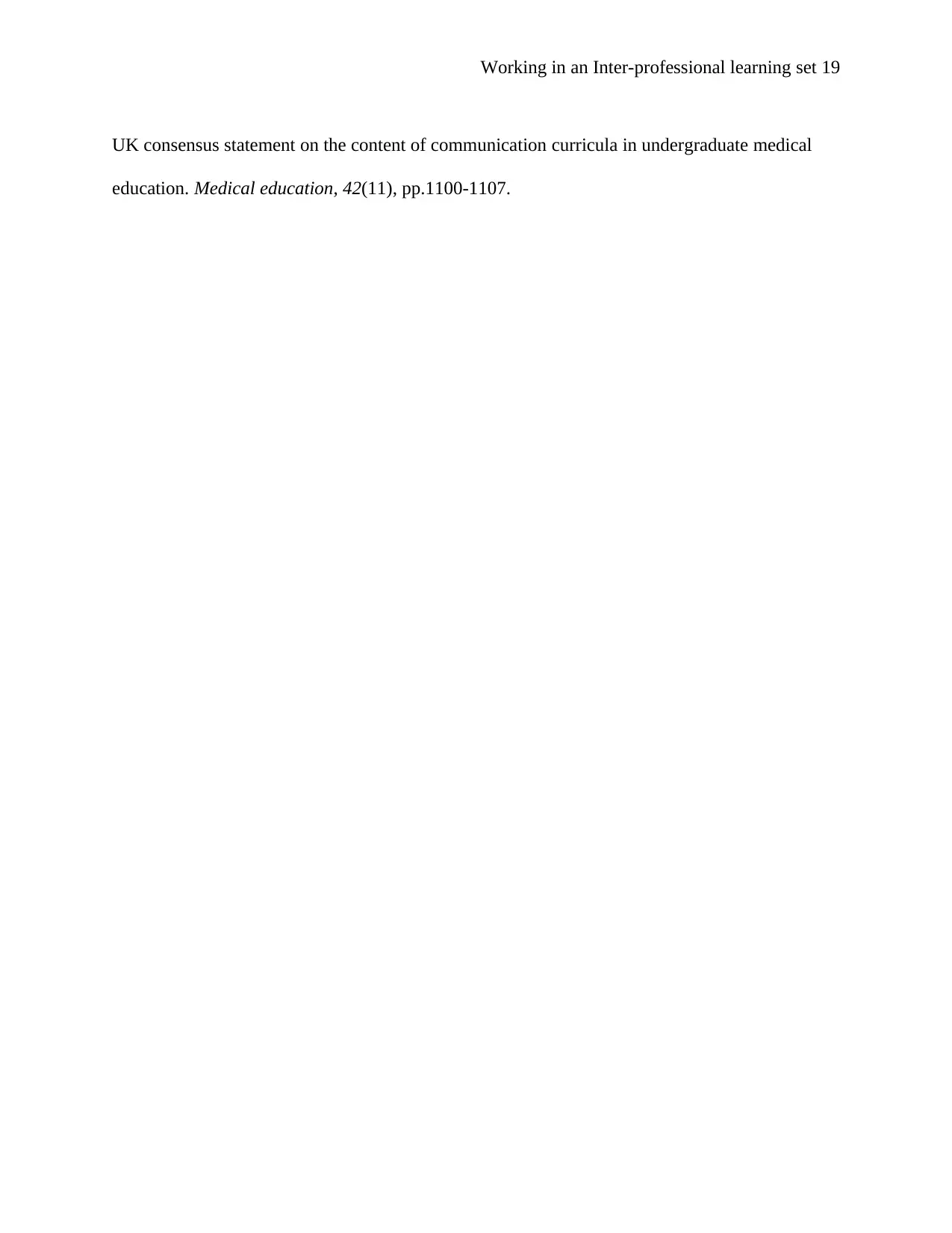
Working in an Inter-professional learning set 19
UK consensus statement on the content of communication curricula in undergraduate medical
education. Medical education, 42(11), pp.1100-1107.
UK consensus statement on the content of communication curricula in undergraduate medical
education. Medical education, 42(11), pp.1100-1107.
1 out of 19
Related Documents
Your All-in-One AI-Powered Toolkit for Academic Success.
+13062052269
info@desklib.com
Available 24*7 on WhatsApp / Email
![[object Object]](/_next/static/media/star-bottom.7253800d.svg)
Unlock your academic potential
© 2024 | Zucol Services PVT LTD | All rights reserved.





